- Paddle Board


What Is a Sailboat Rudder? An Overview of Its Function and Design
Sailboats have been used for thousands of years to traverse water. They have undergone many changes and improvements over the years, and one of the essential components of a sailboat is the rudder.
Quick Facts
Understanding the sailboat rudder.
The rudder is a vital component of a sailboat that plays a crucial role in steering and maneuvering the vessel. The rudder works by changing the direction of the water flow around it, which moves the boat in the opposite direction. Without a rudder, it would be impossible to navigate a sailboat effectively, especially in different water and wind conditions.
Components of a Sailboat Rudder
A sailboat rudder comprises several components, each with a unique function that contributes to the rudder’s overall effectiveness. The stock is the main vertical shaft that connects the rudder blade to the boat’s helm. It is usually made of stainless steel or aluminum alloy and is designed to withstand the forces exerted on the rudder during navigation.
The blade is the flat portion of the rudder that faces the water current and directs the water flow in the opposite direction to steer the boat. The blade is typically made of fiberglass-reinforced plastic or aluminum alloy and is designed to be lightweight and durable. Pintles and gudgeons are the two connections between the rudder and stern that allow for easy installation and removal of the rudder. Pintles are the vertical metal pins that fit into the gudgeons, which are the horizontal metal brackets attached to the boat’s stern.
Different Types of Rudders
There are several types of rudders used in sailboats, each with its advantages and disadvantages. Transom-mounted rudders are the most common type of rudder, and they are mounted on the stern of the boat. Skeg-mounted rudders are attached to a fixed fin called a skeg, which provides additional stability to the rudder.
Keel-mounted rudders are attached to the boat’s keel, which is the central structural element that runs along the bottom of the hull. Spade rudders are free-standing rudders that are not attached to any part of the boat and are commonly used in racing sailboats. The type of rudder used depends on the boat’s size, design, and intended use.
Materials Used in Rudder Construction
Rudders can be made from various materials, each with its advantages and disadvantages. Wooden rudders are the traditional choice and are still used in some sailboats today. However, they are relatively heavy and require regular maintenance to prevent rot and decay.
Aluminum alloy rudders are lightweight and durable, making them an excellent choice for racing sailboats. Stainless steel rudders are also durable but are heavier than aluminum alloy rudders. Fiberglass-reinforced plastic rudders are the most common type of rudder used today, as they are lightweight, durable, and require minimal maintenance.
The sailboat rudder is an essential component that plays a crucial role in steering and maneuvering a sailboat. Understanding the different types of rudders, their components, and the materials used in their construction can help sailors choose the right rudder for their boat and navigate more effectively in different water and wind conditions.

The Function of a Sailboat Rudder
Steering and maneuvering.
The primary function of a sailboat rudder is to steer and maneuver the boat. The rudder’s blade directing the flow of water in a specific direction allows for the steering of the boat as the blade changes direction. Sailors can use the rudder to turn the boat in any direction they choose, allowing them to navigate through narrow channels or around obstacles in the water. It is essential to note that the rudder works in conjunction with the sails to control the boat’s direction and speed.
Balancing the Sailboat
The balance of the sailboat is critical to ensure safe maneuvering, and the rudder plays a crucial role in achieving this. A balanced rudder helps in keeping the boat steady, reducing drag, and preventing unwanted turning. Sailors can adjust the rudder’s angle to keep the boat balanced and on course, especially in rough water conditions. A well-balanced rudder also helps to reduce the risk of capsizing or losing control of the boat .
Rudder Effectiveness in Different Conditions
Rudder effectiveness varies depending on the boat’s size, weight, and water and wind conditions. A larger boat may require a bigger rudder for proper maneuvering, while a smaller boat can work with a smaller rudder. Sailors must also consider the water and wind conditions when choosing the right rudder for their boat. In calm waters, a smaller rudder may be sufficient, but in rough water, a larger rudder may be necessary to maintain control of the boat. Additionally, the rudder’s effectiveness can be affected by the boat’s speed, with higher speeds requiring more significant rudders to maintain control.
It is also important to note that the rudder’s effectiveness can be impacted by external factors such as weeds or debris in the water. These factors can reduce the rudder’s ability to steer the boat and require sailors to make adjustments to maintain control. Additionally, the rudder’s effectiveness can be impacted by the sailor’s skill level, with more experienced sailors able to make more precise adjustments to the rudder to control the boat’s direction and speed.
Design Considerations for Sailboat Rudders
Sailboat rudders are an essential component of a boat’s steering and maneuvering system. A well-designed rudder can make all the difference in a boat’s performance , especially in challenging weather conditions. In this article, we will explore some of the key design considerations for sailboat rudders.
Rudder Size and Shape
The size and shape of a rudder play a crucial role in determining its effectiveness in steering and maneuvering a boat. A larger rudder provides more leverage and maneuverability, allowing the boat to turn more sharply. However, a larger rudder may also produce more drag, which can slow down the boat’s speed.
The shape of the rudder is also important. A well-designed rudder should be streamlined to reduce drag and turbulence. The thickness of the rudder should be carefully considered to ensure that it is strong enough to withstand the forces exerted on it while remaining lightweight.
Rudder Placement and Configuration
The placement of the rudder on the boat can significantly affect its performance. A rudder that is too far forward can cause the boat to become unstable, while a rudder that is too far aft can make it difficult to steer. The location of the rudder must also take into account factors such as the propeller’s placement and the boat’s shape.
The configuration of the rudder can also determine its effectiveness and balance. A single rudder is the most common configuration, but some boats have twin rudders to provide more steering control. The angle of the rudder blade can also be adjusted to optimize its performance.
Hydrodynamic and Aerodynamic Factors
The design of a rudder must take into consideration the hydrodynamic and aerodynamic factors affecting the boat’s performance. Hydrodynamic factors include water flow, pressure, and turbulence, which can significantly affect the rudder’s performance. The shape and placement of the rudder must be carefully designed to minimize these effects.
Aerodynamic factors consider the wind and air resistance’s impact on the boat’s performance. The rudder’s size and shape must be designed to minimize the wind’s effect on the boat while providing sufficient steering control.
The design of a sailboat rudder is a complex process that requires careful consideration of many factors. The size and shape of the rudder, its placement on the boat, and its configuration must be optimized to provide effective steering and maneuverability. By taking into account the hydrodynamic and aerodynamic factors affecting the boat’s performance, a well-designed rudder can significantly improve a sailboat’s overall performance.

Rudder Maintenance and Repair
The rudder is a crucial component of any sailboat, providing steering and control. As such, it’s essential to keep it in good working order through regular maintenance and inspections.
Inspecting Your Rudder
Regular inspection of the rudder is essential to ensure its continued performance and longevity. A thorough inspection includes checking for cracks, wear and tear, and loose components such as hinges, pins, and screws. It’s also important to check the rudder’s alignment and ensure it moves smoothly and without any obstructions.
During your inspection, be sure to check for signs of corrosion, particularly on metal components. Corrosion can weaken the rudder and cause it to fail, so regular cleaning and maintenance are essential to prevent this.
If you notice any issues during your inspection, it’s important to address them promptly. Small cracks or damage can often be repaired, but if the damage is extensive, it may be necessary to replace the rudder entirely.
Common Rudder Issues and Solutions
One common issue with rudders is corrosion, particularly on metal components. Regular cleaning and maintenance help prevent corrosion and ensure the rudder’s longevity. If you do notice signs of corrosion, it’s important to address it promptly to prevent further damage.
Another common issue is damage to the blade or stock. This can be caused by impact with debris or other boats, or simply wear and tear over time. If the damage is minor, it may be possible to repair the rudder. However, if the damage is extensive or compromises the rudder’s structural integrity, it may be necessary to replace it entirely.
Loose components such as hinges, pins, and screws can also cause issues with the rudder. These should be checked regularly and tightened or replaced as needed.
When to Replace or Upgrade Your Rudder
Sailboat rudders can last for many years, but at some point, replacement or upgrade may be necessary. This includes upgrading to a newer design or larger rudder to improve the boat’s performance or replacing a damaged or worn-out rudder that is beyond repair.
If you’re considering upgrading your rudder, it’s important to consult with a professional to ensure that the new rudder is compatible with your boat and will provide the desired performance improvements.
Regular maintenance and inspections are essential to ensure the continued performance and longevity of your sailboat’s rudder. By staying on top of any issues and addressing them promptly, you can ensure that your rudder will continue to provide reliable steering and control for many years to come.

A sailboat’s rudder is a crucial component that helps steer and maneuver the boat safely. The size, shape, placement, and construction materials must all be taken into consideration when designing or replacing a rudder. Regular maintenance and inspection help ensure its continued performance and longevity.
Rudder FAQS
How does a sailboat rudder work.
A sailboat rudder works by changing the direction of the water flow past the boat’s hull, which in turn changes the direction of the boat. The rudder is attached to the stern of the boat and can be turned left or right. When the rudder is turned, it creates a force that pushes the stern in the opposite direction and turns the bow towards the direction the rudder is turned. This is how a rudder steers a boat.
What is a rudder and its purpose?
A rudder is a flat piece, usually made of metal or wood, attached to the stern of a vessel such as a boat or ship. The main purpose of the rudder is to control the direction of the vessel. It does this by deflecting water flow, creating a force that turns the vessel. Without a rudder, steering a vessel would be significantly more challenging.
Can you steer a sailboat without a rudder?
Steering a sailboat without a rudder is challenging but not impossible. Sailors can use the sails and the keel to influence the direction of the boat. By trimming the sails and shifting weight, it’s possible to cause the boat to turn. However, this is a difficult technique that requires a deep understanding of sailing dynamics and is usually considered a last resort if the rudder fails.
What controls the rudder on a sailboat?
The rudder on a sailboat is typically controlled by a steering mechanism, like a tiller or a wheel. The tiller is a lever that is directly connected to the top of the rudder post. Pushing the tiller to one side causes the rudder to turn to the opposite side. On larger boats, a wheel is often used. The wheel is connected to the rudder through a series of cables, pulleys, or hydraulic systems, which turn the rudder as the wheel is turned.
How do you steer a sailboat with a rudder?
To steer a sailboat with a rudder, you use the tiller or wheel. If your sailboat has a tiller, you’ll push it in the opposite direction of where you want to go – pushing the tiller to the right will turn the boat to the left and vice versa. If your sailboat has a wheel, it operates like a car steering wheel – turning it to the right steers the boat to the right and turning it to the left steers the boat to the left.
How do you steer a sailboat against the wind?
Steering a sailboat against the wind, also known as tacking, involves a maneuver where the bow of the boat is turned through the wind. Initially, the sails are let out, and then the boat is steered so that the wind comes from the opposite side. As the boat turns, the sails are rapidly pulled in and filled with wind from the new direction. This maneuver allows the boat to zigzag its way upwind, a technique known as “beating.” It requires skill and understanding of sailing dynamics to execute effectively.

John is an experienced journalist and veteran boater. He heads up the content team at BoatingBeast and aims to share his many years experience of the marine world with our readers.
What to Do If Your Boat Engine Won’t Start? Common Problems & How to Fix Them
How to launch a boat by yourself: complete beginner’s guide, how to surf: complete beginner’s guide to get you started.
Comments are closed.
Type above and press Enter to search. Press Esc to cancel.

My Cruiser Life Magazine
All About the Rudder on a Sailboat
The rudder on a sailboat is one of those important parts that often gets overlooked. It’s hidden underwater most of the time and usually performs as expected when we ask something of it.
But when was the last time you seriously considered your sailboat rudder? Do you have a plan if it fails? Here’s a look at various designs of sail rudder, along with the basics of how it works and why it’s there.
Table of Contents
How are sailboat rudders different than keels, how does the rudder work, wheel steering vs. tiller steering, full keel rudder sailboat, skeg-hung rudders, spade rudder, variations on designs, emergency outboard rudder options, looking to sail into the sunset grab the wheel, steer your sail boat rudder, and get out there, sail boat rudder faqs.
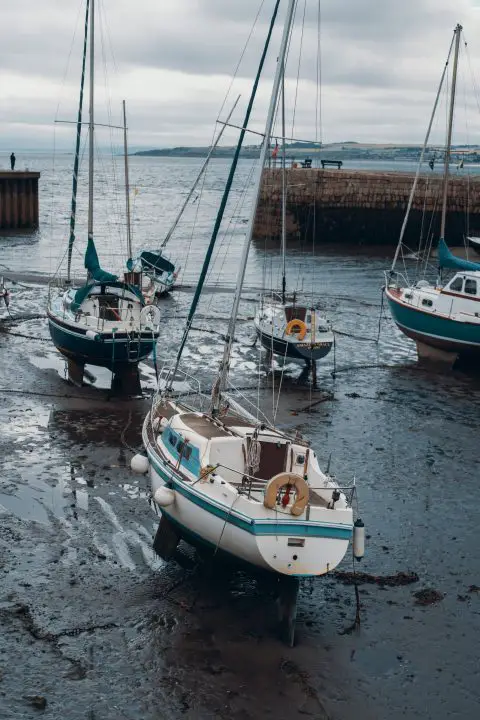
What Is a Boat Rudder?
The rudder is the underwater part of the boat that helps it turn and change direction. It’s mounted on the rear of the boat. When the wheel or tiller in the cockpit is turned, the rudder moves to one side or another. That, in turn, moves the boat’s bow left or right.
When it comes to sailing, rudders also offer a counterbalance to the underwater resistance caused by the keel. This enables the boat to sail in a straight line instead of just spinning around the keel.
Sailboat hull designs vary widely when you view them out of the water. But while the actual shape and sizes change, they all have two underwater features that enable them to sail–a rudder and a keel.
The rudder is mounted at the back of the boat and controls the boat’s heading or direction as indicated by the compass .
The keel is mounted around the center of the boat. Its job is to provide a counterbalance to the sails. In other words, as the wind presses on the sails, the weight of the ballast in the keel and the water pressure on the sides of the keel keeps the boat upright and stable.
When sailing, the keel makes a dynamic force as water moves over it. This force counters the leeway made by air pressure on the sails and enables the boat to sail windward instead of only blowing downwind like a leaf on the surface.
The rudder is a fundamental feature of all boats. Early sailing vessels used a simple steering oar to get the job done. Over the years, this morphed into the rudder we know today.
However, thinking about a rudder in terms of a steering oar is still useful in understanding its operation. All it is is an underwater panel that the helmsperson can control. You can maintain a course by trailing the oar behind the boat while sailing. You can also change the boat’s heading by moving it to one side or the other.
The rudders on modern sailboats are a little slicker than simple oars, of course. They are permanently mounted and designed for maximum effectiveness and efficiency.
But their operating principle is much the same. Rudders work by controlling the way water that flows over them. When they move to one side, the water’s flow rate increases on the side opposite the turn. This faster water makes less pressure and results in a lifting force. That pulls the stern in the direction opposite the turn, moving the bow into the turn.
Nearly all boats have a rudder that works exactly the same. From 1,000-foot-long oil tankers to tiny 8-foot sailing dinghies, a rudder is a rudder. The only boats that don’t need one are powered by oars or have an engine whose thrust serves the same purpose, as is the case with an outboard motor.
Operating the Rudder on a Sailboat
Rudders are operated in one of two ways–with a wheel or a tiller. The position where the rudder is operated is called the helm of a boat .
Ever wonder, “ What is the steering wheel called on a boat ?” Boat wheels come in all shapes and sizes, but they work a lot like the wheel in an automobile. Turn it one way, and the boat turns that way by turning the rudder.
A mechanically simpler method is the tiller. You’ll find tiller steering on small sailboats and dinghies. Some small outboard powerboats also have tiller steering. Instead of a wheel, the tiller is a long pole extending forward from the rudder shaft’s top. The helmsperson moves the tiller to the port or starboard, and the bow moves in the opposite direction. It sounds much more complicated on paper than it is in reality.
Even large sailboats will often be equipped with an emergency tiller. It can be attached quickly to the rudder shaft if any of the fancy linkages that make the wheel work should fail.
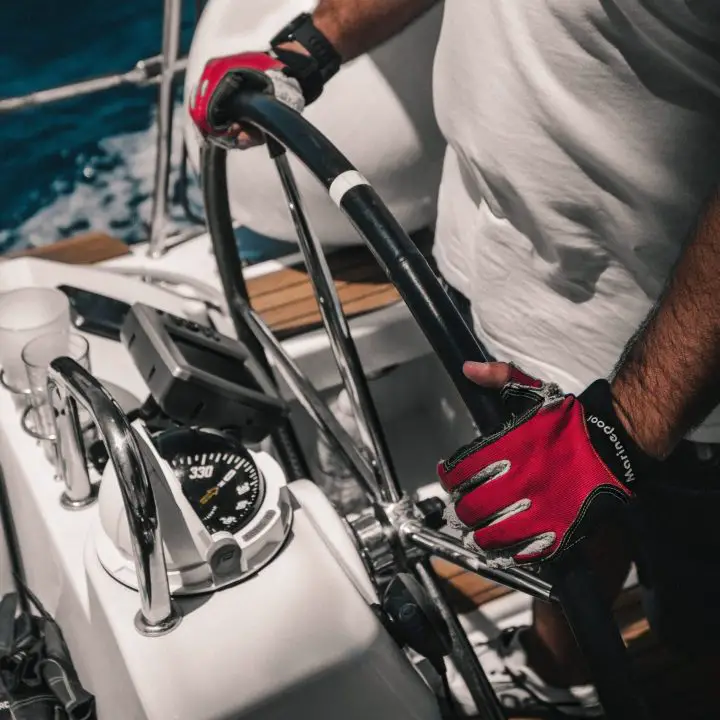
Various Sail Boat Rudder Designs
Now, let’s look at the various types of rudders you might see if you took a virtual walk around a boatyard. Since rudders are mostly underwater on the boat’s hull, it’s impossible to compare designs when boats are in the water.
Keep in mind that these rudders work the same way and achieve the same results. Designs may have their pluses and minuses, but from the point of view of the helmsperson, the differences are negligible. The overall controllability and stability of the boat are designed from many factors, and the type of rudder it has is only one of those.
You’ll notice that rudder design is closely tied to keel design. These two underwater features work together to give the boat the sailing characteristics the designer intended.
The classic, robust offshore sailboat is designed with a full keel that runs from stem to stern. With this sort of underwater profile, it only makes sense that the rudder would be attached to the trailing edge of that enormous keel. On inboard-powered sailboats, the propeller is usually mounted inside an opening called the aperture between the keel and rudder.
The advantages of this design are simplicity and robustness. The keel is integrated into the hull and protects the rudder’s entire length. Beyond reversing into an obstacle, anything the boat might strike would hit the keel first and would be highly unlikely to damage the rudder. Not only does the keel protect it, but it also provides a very strong connection point for it to be attached to.
Full keel boats are known for being slow, although there are modern derivatives of these designs that have no slow pokes. Their rudders are often large and effective. They may not be the most efficient design, but they are safe and full keels ride more comfortably offshore than fin-keeled boats.
Plenty of stout offshore designs sport full keel rudders. The Westsail 38s, Lord Nelsons, Cape Georges, Bristol/Falmouth Cutters, or Tayana 37s feature a full keel design.
A modified full keel, like one with a cutaway forefoot, also has a full keel-style rudder. These are more common on newer designs, like the Albergs, Bristols, Cape Dorys, Cabo Ricos, Island Packets, or the older Hallberg-Rassys.

A design progression was made from full keel boats to long-fin keelboats, and the rudder design changed with it. Designers used a skeg as the rudder became more isolated from the keel. The skeg is a fixed structure from which you can mount the rudder. This enables the rudder to look and function like a full keel rudder but is separated from the keel for better performance.
The skeg-hung rudder has a few of the same benefits as a full keel rudder. It is protected well and designed robustly. But, the cutaways in the keel provide a reduced wetted surface area and less drag underwater, resulting in improved sailing performance overall.
Larger boats featuring skeg-mounted rudders include the Valiant 40, Pacific Seacraft 34, 37, and 40, newer Hallberg-Rassys, Amels, or the Passport 40.
It’s worth noting that not all skegs protect the entire rudder. A partial skeg extends approximately half the rudder’s length, allowing designers to make a balanced rudder.
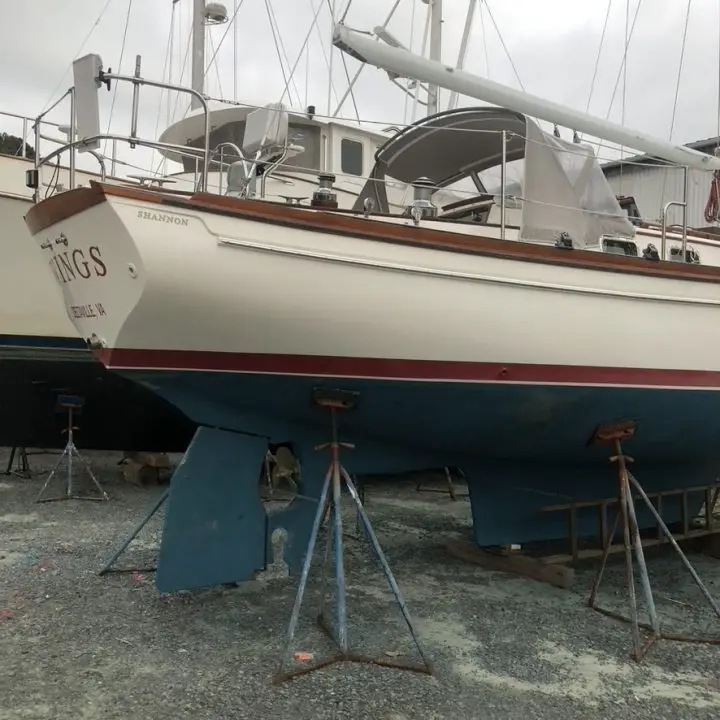
With higher-performance designs, keels have become smaller and thinner. Fin keel boats use more hydrodynamic forces instead of underwater area to counter the sail’s pressure. With the increased performance, skegs have gone the way of the dinosaurs. Nowadays, rudders are sleek, high aspect ratio spade designs that make very little drag. They can be combined with a number of different keel types, including fin, wing keels , swing keels, or bulb keels.
The common argument made against spade rudders is that they are connected to the boat by only the rudder shaft. As a result, an underwater collision can easily bend the shaft or render the rudder unusable. In addition, these rudders put a high load on the steering components, like the bearings, which are also more prone to failure than skeg or full keel designs. For these reasons, long-distance cruisers have traditionally chosen more robust designs for the best bluewater cruising sailboats .
But, on the other hand, spade rudders are very efficient. They turn the boat quickly and easily while contributing little to drag underwater.
Spade rudders are common now on any boat known for performance. All racing boats have a spade rudder, like most production boats used for club racing. Pick any modern fin keel boat from Beneteau, Jeanneau, Catalina, or Hunter, and you will find a spade rudder. Spade rudders are common on all modern cruising catamarans, from the Geminis to the Lagoons, Leopards, and Fountaine Pajots favored by cruisers and charter companies.
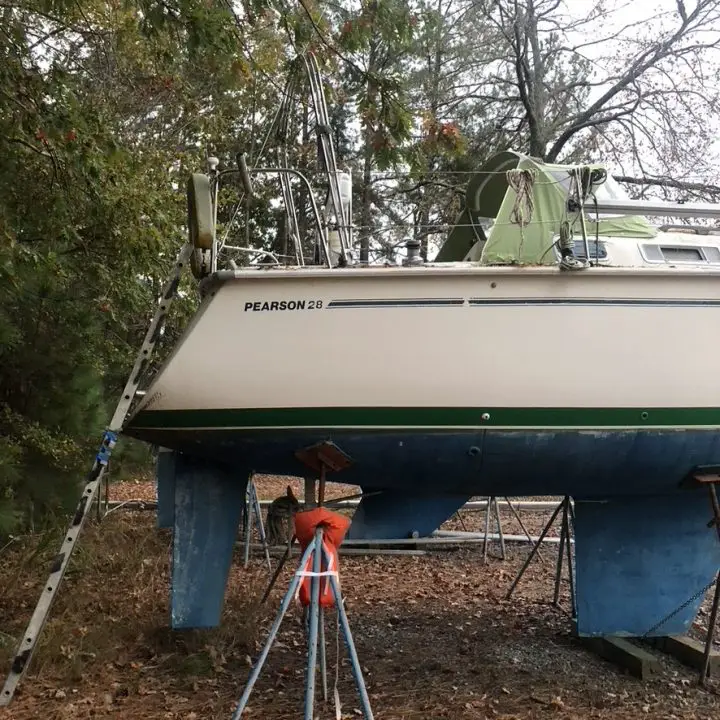
Here are two alternative designs you might see out on the water.
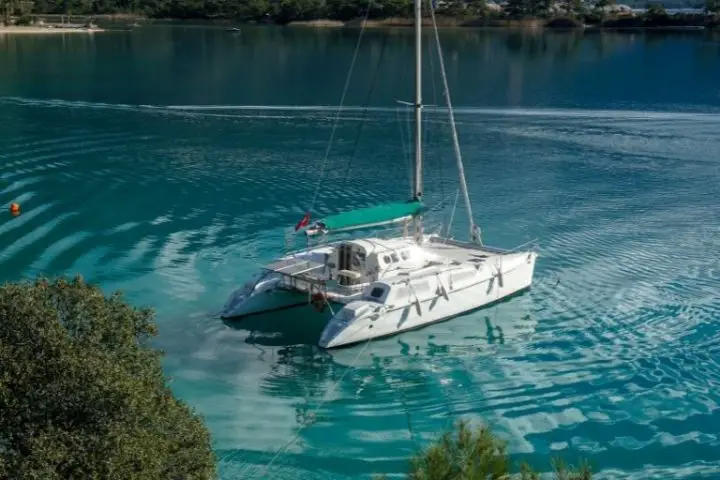
Transom-Hung or Outboard Rudders
An outboard rudder is hung off the boat’s transom and visible while the boat is in the water. Most often, this design is controlled by a tiller. They are common on small sailing dingies, where the rudder and tiller are removable for storage and transport. The rudder is mounted with a set of hardware called the pintle and gudgeon.
Most outboard rudders are found on small daysailers and dinghies. There are a few classic big-boat designs that feature a transom-hung rudder, however. For example, the Westsail 38, Alajuela, Bristol/Falmouth Cutters, Cape George 36, and some smaller Pacific Seacrafts (Dana, Flicka) have outboard rudders.
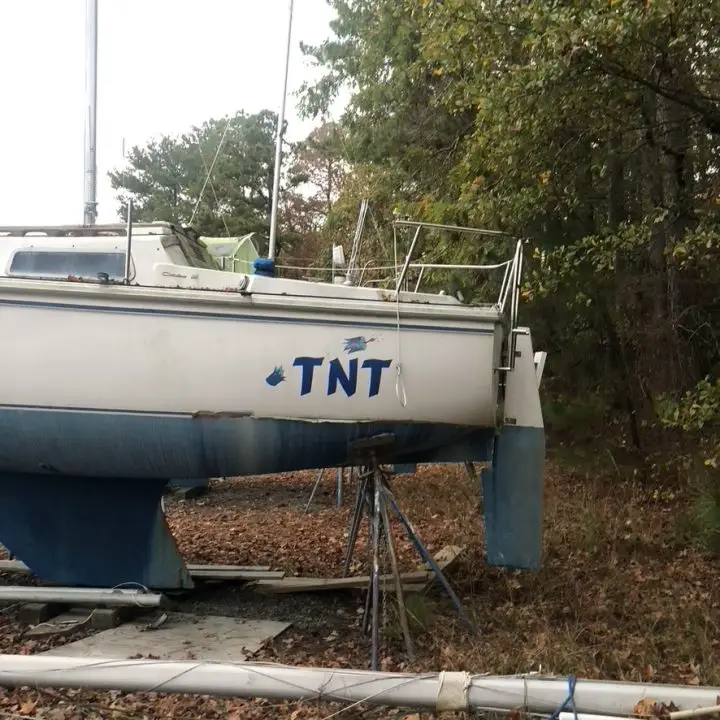
Twin Sailing Rudder Designs
A modern twist that is becoming more common on spade rudder boats is the twin sailboat rudder. Twin rudders feature two separate spade rudders mounted in a vee-shaped arrangement. So instead of having one rudder pointed down, each rudder is mounted at an angle.
Like many things that trickle down to cruising boats, the twin rudder came from high-performance racing boats. By mounting the rudders at an angle, they are more directly aligned in the water’s flow when the boat is healed over for sailing. Plus, two rudders provide some redundancy should one have a problem. The twin rudder design is favored by designers looking to make wide transom boats.
There are other, less obvious benefits of twin rudders as well. These designs are easier to control when maneuvering in reverse. They are also used on boats that can be “dried out” or left standing on their keel at low tide. These boats typically combine the twin rudders with a swing keel, like Southerly or Sirius Yachts do. Finally, twin rudders provide much better control on fast-sailing hulls when surfing downwind.
Unbalanced vs. Balanced Rudders
Rudders can be designed to be unbalanced or balanced. The difference is all in how they feel at the helm. The rudder on a bigger boat can experience a tremendous amount of force. That makes turning the wheel or tiller a big job and puts a lot of strain on the helmsperson and all of the steering components.
A balanced rudder is designed to minimize these effects and make turning easier. To accomplish this, the rudder post is mounted slightly aft of the rudder’s forward edge. As a result, when it turns, a portion of the leading edge of the rudder protrudes on the opposite side of the centerline. Water pressure on that side then helps move the rudder.
Balanced rudders are most common in spade or semi-skeg rudders.
Sail Rudder Failures
Obviously, the rudder is a pretty important part of a sailboat. Without it, the boat cannot counter the forces put into the sails and cannot steer in a straight line. It also cannot control its direction, even under power.
A rudder failure of any kind is a serious emergency at sea. Should the rudder be lost–post and all–there’s a real possibility of sinking. But assuming the leak can be stopped, coming up with a makeshift rudder is the only way you’ll be able to continue to a safe port.
Rudder preventative maintenance is some of the most important maintenance an owner can do. This includes basic things that can be done regularly, like checking for frayed wires or loose bolts in the steering linkage system. It also requires occasionally hauling the boat out of the water to inspect the rudder bearings and fiberglass structure.
Many serious offshore cruisers install systems that can work as an emergency rudder in extreme circumstances. For example, the Hydrovane wind vane system can be used as an emergency rudder. Many other wind vane systems have similar abilities. This is one reason why these systems are so popular with long-distance cruisers.
There are also many ways to jury rig a rudder. Sea stories abound with makeshift rudders from cabinet doors or chopped-up sails. Sail Magazine featured a few great ideas for rigging emergency rudders .
Understanding your sail rudder and its limitations is important in planning for serious cruising. Every experienced sailor will tell you the trick to having a good passage is anticipating problems you might have before you have them. That way, you can be prepared, take preventative measures, and hopefully never deal with those issues on the water.
What is the rudder on a sailboat?
The rudder is an underwater component that both helps the sailboat steer in a straight line when sailing and turn left or right when needed.
What is the difference between a rudder and a keel?
The rudder and the keel are parts of a sailboat mounted underwater on the hull. The rudder is used to turn the boat left or right, while the keel is fixed in place and counters the effects of the wind on the sails.
What is a rudder used for on a boat?
The rudder is the part of the boat that turns it left or right
Matt has been boating around Florida for over 25 years in everything from small powerboats to large cruising catamarans. He currently lives aboard a 38-foot Cabo Rico sailboat with his wife Lucy and adventure dog Chelsea. Together, they cruise between winters in The Bahamas and summers in the Chesapeake Bay.
Leave a comment
Your email address will not be published. Required fields are marked *
Save my name, email, and website in this browser for the next time I comment.

What is a Sailboat Rudder?

Last Updated by
Daniel Wade
June 15, 2022
A sailboat rudder steers the boat. A rudder is a hinged fin or blade mounted on the stern of the vessel that turns side to side, and it's controlled by a tiller or a helm.
A rudder is one of the primary controls of a sailboat. When the boat moves forward through the water, the rudder causes friction on one side and changes the direction of the boat. Rudders are controlled by moving a tiller side to side or by a helm and a complex linkage system. Rudders are delicate and sometimes flush with and protected by the keel.
Table of contents
Identifying the Rudder
Rudders are connected to the sailboat using a hinge or a shaft. The rudder is always located in the water behind the boat, but some rudders have part of their structure exposed above the waterline. Rudders that aren't visible above the waterline are usually underneath the stern and controlled by a vertical shaft that descends through the bottom of the boat.
Rudder Design
Rudder design varies widely between boats. Some vessels have large, ornate rudders that are exposed above the waterline. Large rudders are common on catboats, canoe yawls, and other traditional designs.
Many modern boats use small, blade-like rudders that are hidden from view. The size of a rudder doesn't necessarily correlate with its effectiveness, but an improperly sized rudder can cause significant issues.
How Does a Sailboat Rudder Work?
Sailboat rudders are simple devices. Rudders are essentially deflectors, as they deflect water to port or starboard as the boat moves along. When the rudder is amidships or in the middle and aligned with the keel, the boat goes straight. Rudders also help keep the boat on a straight track as they increase the area of water moving down the length of the boat.
Rudders only work when the boat is moving. If there's no moving water to deflect, the rudder can do little to direct the vessel. Rudders also don't work when the boat is blown sideways. Maneuvering is only possible when the boat is moving forward.
Can a Sailboat Rudder Steer in Reverse?
But what about moving in reverse? Rudders can be used to steer the boat in reverse, but they're significantly less effective when pushed backward through the water. The distance required to make a turn in reverse is usually much higher than when moving forward, and steering input is less precise. In some cases, sailboat rudders can break off when moving too quickly in reverse.
Sailboat Steering Characteristics
Sailboats steer much differently than cars, and there aren't any brakes to slow down with. Sailboats tend to steer from the middle; picture a fan blade spinning slowly on a motor, and you'll get the picture. As a result, steering too aggressively in tight quarters can cause your bow or stern to hit something that's beside you.
Speed is generally helpful for steering, especially when you want to make precise movements quickly. However, speed is a double-edged sword, as slight rudder movement at speed can dramatically and rapidly alter the course of the boat. But remember, you can't steer without moving forward.
Tiller Steering
Sailboat rudders are often controlled by a tiller. Tillers are a long rod connected to the rudder. Sailors move the rod side to side from the cockpit to turn the rudder directly. Tillers are the simplest form or rudder control, and they're highly reliable. Tillers point in the opposite direction that the boat will travel.
Tiller steering is found most often on small boats. This is because the forces involved in steering boats of greater size can be too difficult to manage with a tiller. That said, there are some relatively large boats with cockpit configurations that allow for the use of a tiller. Sailboats with tillers range in size between 10 feet and 30 feet.
Benefits of a Tiller
Tillers have numerous benefits. Tillers offer precise control of the boat because they connect the rudder directly to the person steering the boat. Additionally, tillers are extremely simple and robust. Many blue water sailors prefer tiller steering, as it's difficult to break and easy to repair.
Over the years, sailors have developed many creative ways to make tillers more useful. Many boats feature tiller extensions that allow the sailor to steer from further away. Tillers also respond much faster than helms, which is great for racing and pushing the limits of the boat.
Tiller Self-Steering
Bluewater sailors developed an extremely useful way to multitask onboard a tiller-equipped sailboat. Self-steering is possible on vessels with a tiller, and no electronics or complex machines are necessary. Self-steering involves connecting the jib sheet to a series of pulleys and opposing bungee cord (or surgical tubing).
As the tension on the jib increases, it'll tighten the jib sheet and pull the tiller and change the course of the boat. The opposite is also true. This keeps the boat at the right angle to the wind and is useful for solo travel. GPS-guided self-steering equipment is also available for tiller-equipped sailboats, and it's relatively easy to install.
Helm Steering
A helm is essentially a large nautical steering wheel. Steering a boat with a helm is somewhat similar to driving a car, as the boat moves in the direction that you steer (unlike a tiller, which moves in the opposite direction). Sailboats equipped with tillers are usually larger. Some larger sailboats have two helms placed side-by-side in the cockpit.
The helm consists of a steering wheel and a pedestal which is mounted to the deck. Helm pedestals often feature a marine compass to make navigation possible from one location. Engine controls are often located nearby as well. Sailboat helms are often large in diameter, sometimes 30 inches or more. Large wheels make steering easy and precise.
Helm-equipped sailboats are generally 30-feet long and larger. Tillers are excellent for large boats, as they enable precise movement and require little effort to use. This is especially important at speed when the force of water rushing by a large rudder can be too difficult to overcome with a tiller.
The helm is connected to the rudder mechanically or hydraulically. Some high-end sailboats incorporate power steering, but this is unusual on most consumer vessels. Mechanical helm linkage typically utilizes a cable (or multiple cables and pulleys) that stretches from the helm to the rudder.
Hydraulic Rudder Control
Most sailboat helms are hydraulic. These helms use pressurized hydraulic fluid and small diameter lines to replicate the wheel movements at the rudder. Hydraulic systems often include a fluid reservoir and a pressure cylinder, along with mechanical parts to transfer the force at the wheel and the rudder.
Rudder Maintenance
Rudder maintenance is fairly simple and should be performed regularly. As with the hull, rudders are an ideal habitat for all kinds of unwelcome marine life. Within a year or less, your rudder can be completely encapsulated in barnacles, plants, and other organisms. Marine growth will negatively impact your speed and steering, so it must be scraped off regularly.
Maintaining the steering system is also essential. Tillers are relatively easy to maintain, as they use very few moving parts. Look for grease fittings, and make sure your tiller and rudder are fastened tightly. Helms are more complex, and the hydraulic system should be inspected, repaired, and topped off if necessary.
What to Do if the Rudder is Damaged
Rudder damage is a sailor's worst nightmare, and it's akin to a hole in the hull or losing a mast. So what should you do if your rudder gets damaged or breaks off? First, call for help! But if help isn't available, there are a few makeshift ways to steer the boat without the rudder.
If you have an outboard motor, use it to steer. If not, then a run-of-the-mill rowboat oar makes an excellent rudder substitute. Simply lash the oar to the back of the boat with the end in the water, and use it like a tiller. It's not ideal, but it worked for the Romans, and it should work for you. Some sailors have fashioned makeshift rudders from interior cabinet doors, hatches, scrap metal, and whatever else is on hand.
Losing a rudder is a worst-case-scenario, and it doesn't often happen when sailors keep up with maintenance and stay away from dangerous water. Preventative maintenance and proper navigation are the best ways to keep your rudder in good shape.
Related Articles
I've personally had thousands of questions about sailing and sailboats over the years. As I learn and experience sailing, and the community, I share the answers that work and make sense to me, here on Life of Sailing.
by this author
Sailboat Parts
Learn About Sailboats
Most Recent

What Does "Sailing By The Lee" Mean?
October 3, 2023

The Best Sailing Schools And Programs: Reviews & Ratings
September 26, 2023
Important Legal Info
Lifeofsailing.com is a participant in the Amazon Services LLC Associates Program, an affiliate advertising program designed to provide a means for sites to earn advertising fees by advertising and linking to Amazon. This site also participates in other affiliate programs and is compensated for referring traffic and business to these companies.
Similar Posts

Affordable Sailboats You Can Build at Home
September 13, 2023

Best Small Sailboat Ornaments
September 12, 2023

Discover the Magic of Hydrofoil Sailboats
December 11, 2023
Popular Posts

Best Liveaboard Catamaran Sailboats
December 28, 2023

Can a Novice Sail Around the World?
Elizabeth O'Malley

4 Best Electric Outboard Motors

How Long Did It Take The Vikings To Sail To England?

10 Best Sailboat Brands (And Why)
December 20, 2023

7 Best Places To Liveaboard A Sailboat
Get the best sailing content.
Top Rated Posts
Lifeofsailing.com is a participant in the Amazon Services LLC Associates Program, an affiliate advertising program designed to provide a means for sites to earn advertising fees by advertising and linking to Amazon. This site also participates in other affiliate programs and is compensated for referring traffic and business to these companies. (866) 342-SAIL
© 2024 Life of Sailing Email: [email protected] Address: 11816 Inwood Rd #3024 Dallas, TX 75244 Disclaimer Privacy Policy
How Does the Rudder Work?
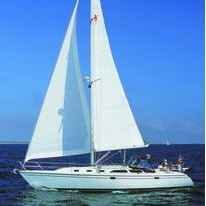
- During turns the boat pivots around a point near its midsection—roughly at the mast on a sloop. The stern moves one way, the bow moves the other way, as the boat changes direction. In very close quarters it’s important for the helmsman to remember this, and make allowances for the swinging stern to avoid bumping into other boats, docks, buoys, etc. Most new sailors make this mistake, but rarely more than once.
- Most smaller sailboats (under 30 feet or so) use a “tiller” to turn the rudder. This is basically a stick made of wood or, sometimes, aluminum, attached to the top of the rudder. The tiller provides leverage to turn the rudder against the pressure of the water moving across it. This pressure can be substantial, so even on a small boat the tiller is usually three or four feet long; in strong winds the helmsman will often wish it were longer still. Therefore, larger boats generally use a wheel, attached to the rudder by cables and a steel “quadrant” to provide sufficient leverage. While steering with a wheel takes less effort, a tiller is better for folks learning to sail, since it provides instant response and feedback: if the sails are trimmed incorrectly, the skilled helmsman will feel it through the tiller. Because of this, some expert racing sailors prefer a tiller, even on large sailboats.
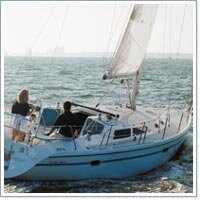
Join Our Newsletter!
Get community news, buying bargains, and how-to guides at your fingertips.
- Understanding boat rudders: Navigating the key component for smooth sailing
Navigating a boat requires a complex interplay of various components, and one of the most crucial elements is the rudder. In this comprehensive guide, we will delve into the world of boat rudders, exploring their functionality, importance, and role in steering a ship to smooth sailing.
What are boat rudders?
Boat rudders are an essential component of the vessel's steering system. They are hydrofoil-like structures located at the stern (rear) of the boat, underwater. The primary function of the rudder is to control the direction of the boat by redirecting the flow of water as the boat moves forward.
The role of boat rudders in steering
Boat rudders play a vital role in steering a ship. When the helmsman turns the wheel or tiller, the rudder changes its angle, redirecting the water flow on one side of the boat, creating more resistance on that side, and causing the boat to turn in the opposite direction.
Types of boat rudders
Spade rudders: Spade rudders are simple and streamlined rudders attached directly to the hull. They are commonly found in modern sailboats and provide excellent maneuverability and responsiveness.
Skeg rudders: Skeg rudders are partially submerged and supported by a skeg, a vertical extension of the hull. These rudders offer increased protection and are often used in larger motorboats and trawlers.
Balanced rudders: Balanced rudders have a portion of the rudder forward of the pivot point, which balances the force applied by the helmsman. This design reduces the effort required to steer the boat.
Barn door rudders: Barn door rudders are large, flat, and wide rudders resembling barn doors. They are commonly seen in traditional fishing vessels and provide excellent control in rough seas.
Spade hung rudders: Spade hung rudders are free-floating rudders attached to the boat only at the top, allowing them to swing freely. They are commonly used in high-performance sailing yachts.
Read our top notch articles on topics such as sailing, sailing tips and destinations in our Magazine .
Components and mechanics of boat rudders
A typical boat rudder consists of several key components:
Rudder blade: The rudder blade is the flat, vertical surface responsible for redirecting the water flow. It is the most critical part of the rudder and comes in various shapes and sizes.
Rudder stock: The rudder stock is a sturdy vertical shaft that connects the rudder blade to the steering mechanism. It provides the necessary support and stability for the rudder.
Tiller or wheel: The tiller or wheel is the steering control operated by the helmsman. When turned, it causes the rudder to change its angle and steer the boat.
Rudder bearings: Rudder bearings are the mechanisms that allow the rudder to pivot smoothly on the rudder stock. Properly lubricated and maintained bearings ensure easy steering.
Steering linkage: The steering linkage consists of rods or cables connecting the tiller or wheel to the rudder stock. It transmits the helmsman's steering inputs to the rudder.
Steering a ship: The interaction between rudder and helm
The process of steering a ship involves a coordinated effort between the rudder and the helm. When the helmsman turns the wheel or tiller, the rudder angle changes, causing a difference in water flow on either side of the boat. This creates a force imbalance, turning the boat in the desired direction.
The effectiveness of the steering system depends on various factors, such as the rudder's size, shape, and angle, the vessel's speed, and the water conditions. Proper coordination between the helmsman and the rudder is essential for precise maneuvering.
Maintaining and repairing boat rudders
Regular maintenance is crucial to ensure the optimal performance and longevity of boat rudders. Here are some maintenance tips:
Inspect for damage: Regularly inspect the rudder blade, stock, and bearings for any signs of wear, damage, or corrosion.
Lubrication: Ensure the rudder bearings are well-lubricated to prevent friction and allow smooth movement.
Antifouling: Apply antifouling paint to the rudder to prevent marine growth, which can negatively impact performance.
Check steering linkage: Inspect and adjust the steering linkage regularly to maintain precise control.
Address issues promptly: If any problems or abnormalities are detected, address them promptly to prevent further damage.
Rudder design innovations
Advancements in technology have led to innovative rudder designs aimed at improving performance and efficiency. Some notable innovations include:
Hydrodynamic profiles: Rudder blades are now designed with advanced hydrodynamic profiles to reduce drag and enhance maneuverability.
Rudder fins: Some rudders are equipped with additional fins or foils to improve stability and minimize yawing motion.
Retractable rudders: Certain sailboats feature retractable rudders, which can be raised when sailing in shallow waters, reducing the risk of grounding.
Steer-by-wire systems: Modern vessels are adopting steer-by-wire systems, replacing traditional mechanical linkages with electronic controls for smoother steering.
The influence of rudder size and shape on turning radius
The size and shape of the rudder directly impact the vessel's turning radius. Larger rudders with greater surface area provide more steering force and can turn the boat more quickly. However, larger rudders also create more drag, which can affect overall speed and fuel efficiency. The optimal rudder size depends on the boat's size, weight, and intended use.
Rudder efficiency and hydrodynamics
The hydrodynamics of the rudder significantly affect its efficiency. Smooth and streamlined rudder designs minimize drag and turbulence, resulting in improved performance and fuel economy. Advanced hydrodynamic analysis and simulation tools help optimize rudder shapes for various vessels and operating conditions.
Common rudder issues and troubleshooting
Like any mechanical component, boat rudders can experience issues over time. Some common problems and troubleshooting tips include:
Stiff steering: If the steering feels stiff or unresponsive, check for obstructions in the rudder bearings or linkage.
Vibrations: Vibrations during steering may indicate misaligned rudder blades or bent rudder stocks.
Leaking bearings: Leaking rudder bearings require immediate attention to prevent water ingress and corrosion.
Excessive play: Excessive play in the rudder could be due to worn steering linkage or loose connections.
Reduced maneuverability: Reduced maneuverability may result from a fouled or damaged rudder blade.
Rudder steering systems
Various steering systems are employed in conjunction with rudders, each offering unique advantages:
Tiller steering: Common in smaller boats, tiller steering directly connects the tiller to the rudder stock, providing direct and responsive control.
Wheel steering: Larger boats often use wheel steering, which utilizes a mechanical or hydraulic system to transfer steering inputs to the rudder.
Hydraulic steering: Hydraulic steering systems offer smooth and effortless steering, ideal for larger vessels.
Electric steering: Electric steering systems, also known as electro-hydraulic steering or electronic power steering (EPS), utilize electric motors to assist in steering the boat. These systems work in conjunction with hydraulic components, making steering more effortless and responsive for the boat operator.
So what are you waiting for? Take a look at our range of charter boats and head to some of our favourite sailing destinations .
FAQs about rudders
The Types of Sailboat Rudders
- Snowboarding
- Scuba Diving & Snorkeling
Full Keel Rudder
On a sailboat , as the rudder is moved to one side by means of the tiller or steering wheel, the force of the water striking one edge of the rudder turns the stern in the other direction to turn the boat. Different types of rudders have different advantages and disadvantages. The type of rudder is often related to the boat’s type of keel.
Rudder on Full-Keel Sailboat
As shown in this photo, the rudder of a full-keel boat is usually hinged to the aft edge of the keel, making a continuous surface. The engine’s propeller is usually positioned in an aperture between the keel and rudder.
Advantages of Full Keel Rudder
The primary benefit of this rudder configuration is the strength and protection provided to the rudder. It is hinged at top and bottom, well distributing the forces on the rudder. Rope (such as lobster pot warps) or debris in the water cannot snag on the rudder.
Disadvantage of Full Keel Rudder
Because the sideways force of the water on the rudder is entirely behind the rudder’s pivoting point at its leading edge, putting all the force on one side of the rudder, it takes more energy to move the rudder. This is one reason why larger boats seldom have tillers—because it can require much force to “push” the rudder out against the water streaming past the keel.
Spade Rudder
Most fin keel boats have a spade rudder, which extends straight down from the aft hull section. The rudder post comes down through the hull into the rudder itself, allowing the entire rudder to rotate to either side, pivoting around the post.
Advantages of Spade Rudder
The spade rudder is self-standing and does not require a full keel or skeg for its mounting. The rudder post inside the rudder can be moved aft from the leading edge (see next page on Balanced Rudder) so that the force of the water is not all on one side when the rudder is turned. This requires less energy to steer than with a keel- or skeg-mounted rudder.
Disadvantage of Spade Rudder
A spade rudder is more vulnerable to debris or objects in the water, which may strike the rudder and exert a force on the rudder post, the only structure supporting the whole rudder. Even the force of water when the boat “falls” off a wave can exert damaging stress on a spade rudder. If the rudder post is bent, the rudder may jam and become useless.
Balanced Spade Rudder
Note the clear air space at the top of the leading edge of this balanced spade rudder. The rudder post is several inches back from the front of the rudder. When the rudder is turned, the leading edge rotates to one side of the boat while the trailing edge rotates to the other side. While the turning action on the boat is the same, the forces on the helm are more nearly balanced, making it very easy to steer.
Skeg-Mounted Rudder
Some fin keel sailboats have a skeg-mounted rudder like the one shown. The skeg offers the same advantages as a keel mounted rudder: the rudder is protected from objects in the water and has more structural strength than a rudder mounted only on the rudder post.
It also has the same disadvantage: because it is not “balanced” as a spade rudder may be, with water forces distributed on both sides, it requires more force to turn the rudder.
Outboard Rudder
An outboard rudder is mounted outside the hull on the boat’s stern, such as shown in this photo, rather than below the hull using a rudder post or hinges to the keel or skeg. Most outboard rudders are turned with a tiller rather than a steering wheel since there is no rudder post to which to gear a wheel.
Advantages of Outboard Rudder
An outboard rudder does not require a hole through the hull for a rudder post and thus is less likely to cause trouble if damaged. The rudder can often be removed or serviced while the boat is still in the water. Hinges at the top and bottom of the rudder section may provide more strength than a single rudder post.
Disadvantages of Outboard Rudder
Like a spade rudder, an outboard rudder is vulnerable to being struck by or caught in objects or rope in the water. Unlike a spade rudder it cannot be balanced in the water flow, so the force of water is always on one side of the pivot point, requiring more energy for turning the rudder.
A rudder is often related to keel shape .
- Choosing a Centerboard or Fixed Keel Sailboat
- Learn How to Sail a Small Sailboat – 1. The Parts of the Boat
- Control Your Tiller Without a Tiller-Tamer
- Choosing an Inboard or Outboard Engine
- 6 Types of Boat Engines
- How to Tow a Dinghy Behind a Sailboat
- How to Heave To a Sailboat
- The Sunfish: A Perfect Lake or Urban Sailboat
- How to Anchor a Sailboat
- Do It Yourself Boat Trailer Tongue Extension
- Simple Reefing System for Sailors
- How to Rig a Preventer Line
- How Brake Calipers Work
- How to Frog Kick
- RC Airplane Parts and Controls
- From A-Z: A Star Wars Glossary

Professional BoatBuilder Magazine
The rudimentaries of rudders.
By Steve D'Antonio , Jul 12, 2018

Even stoutly constructed rudders are vulnerable to deterioration over time, especially when mild steel or high-carbon-stainless steel is buried in composite foil sections, which inevitably become saturated with seawater.
Like other systems and gear aboard cruising and commercial vessels, rudders have terms to identify their parts and functions. When measuring a rudder, the span and chord are the vertical height and fore-and-aft width, respectively, while the top of portion closest to the hull is referred to as the root , and the bottom is called the tip . Another term frequently used when discussing rudder design, particularly for sailing vessels, is aspect ratio —simply the square of the rudder’s span divided by the rudder’s area. As a rule of thumb, longer, narrower rudders are more efficient than short, wide rudders, and the aspect ratio describes precisely this relationship. Thus, rudders on high-performance sailing vessels are said to have a high-aspect ratio. Walking around a boatyard one day and measuring a few cruising sailboat rudders, I came up with aspect ratios of between 1.7 and 2.1, while one high-performance sailing vessel’s rudder came in at 3.5. The 20-knot semi-displacement lobster yacht’s rudder I measured yielded an even 2.0 aspect ratio, which is considered respectable for this application.
More identifiable rudder components include the stock ; web or armature ; rudderport or log ; stuffing box or compression tube ; bearing ; gudgeon ; and pintle . Not every rudder has all these components.
Rudderstocks
The rudderstock is essentially a shaft or tube that protrudes from the top and sometimes the bottom, depending upon type, of many rudder designs. Because this component provides the primary connection between the rudder’s blade (the flat section that imparts the steering force) and the vessel’s steering system, its design, construction, and material are consequential.
Most stocks are made of stainless steel, bronze, or aluminum, while some are carbon fiber, and they may be solid or hollow. Stainless steel is by far the most common, but it has a penchant for crevice corrosion when exposed to oxygen-depleted water. Insidiously, corrosion nearly always occurs in places where it cannot easily be seen—such as inside many composite (fiberglass and core material) rudder blades and beneath flax-type stuffing-box packing (the problem is exacerbated when the vessel is used infrequently).
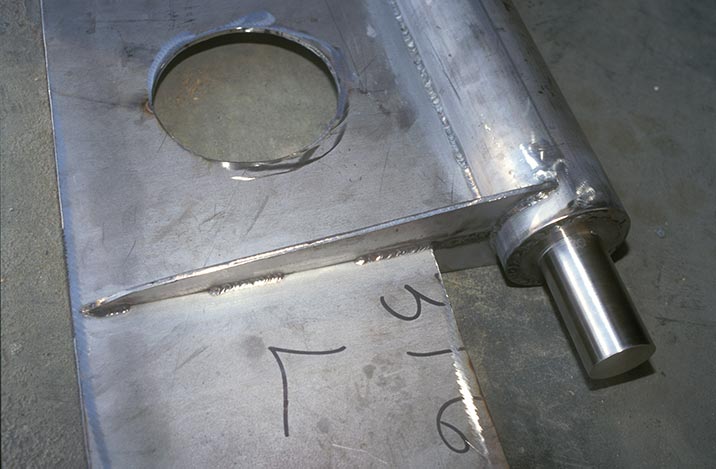
This all-stainless rudderstock and webbing is well crafted and ready to be covered with its composite shell.
Of the stainless steel alloys, some resist this corrosion better than others. Stainless-steel rudderstocks should be manufactured with strong, highly corrosion-resistant proprietary shafting alloys such as A22. The next best choice is 316L stainless steel, which also resists crevice corrosion well. Critically important is the L suffix, meaning “low carbon,” a requirement if it is to be welded, as nearly every rudderstock must be, to the support within composite rudders, or to all-metallic plate-steel rudders. Failure to source low-carbon stainless steel for the stock or the web leads to weld decay, sometimes referred to as carbide precipitation, where the region around the weld loses its resistance to corrosion and rusts when exposed to water.
Aluminum rudderstocks are nearly always tubular. Common on aluminum vessels to reduce the likelihood of galvanic corrosion, aluminum stocks are also relatively common on fiber reinforced plastic (FRP) vessels, particularly large ones. Rudder blades, particularly on aluminum vessels, are often fabricated from aluminum. Of the various aluminum alloys, only a few possess the necessary corrosion-resistance and strength necessary for use as rudderstocks. Of these, the 6000 series, and 6082 in particular—an alloy of aluminum, manganese, and silicon—are popular for this application.
Because aluminum, like stainless steel, suffers from corrosion, it should not be used as stock or web material in composite rudders. Referred to as poultice corrosion, it occurs when aluminum is exposed to oxygen-depleted water. Because oxygen is what allows aluminum to form its tough, corrosion-resistant oxide coating, the metal should never be allowed to remain wet and starved of air as it would be inside a composite rudder blade after water makes its way in around the stock and pintle.
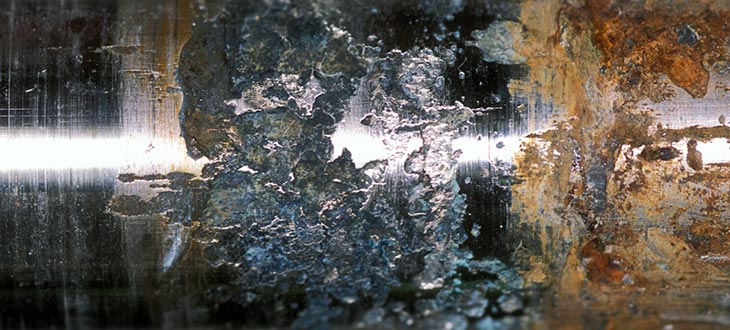
Rudderstock material can corrode in way of the oxygen-starved environment around the packing in a stuffing box.
Bronze, a once popular rudderstock material, is no longer common in today’s production vessels. Although strong and exceptionally corrosion resistant (immune to crevice corrosion), bronze is not easily welded to attach to a rudder’s internal structural webbing, and has thus been supplanted by stainless alloys. Bronze rudderstocks, particularly those that have seen many sea miles, are also known for wearing, or hourglassing, within stuffing boxes, where the flax rides against the stock. If a bronze stock rudder is chronically leaky, disassemble the stuffing box and check for excessive wear. The same is true for stainless and aluminum stocks: chronic leakage is often an indication of corrosion at the packing. Finally, because of their galvanic incompatibility, neither bronze nor copper alloys should be used aboard aluminum vessels for rudderstocks or any other rudder or stuffing box components.
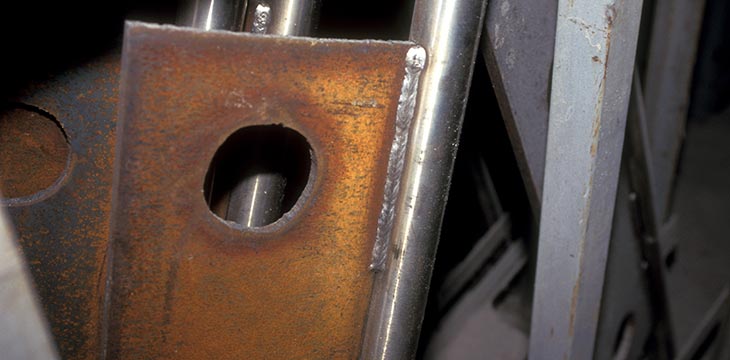
Mild-steel webbing welded to a stainless-steel rudderstock is a recipe for eventual corrosion and failure.
The webbing, or internal metallic support system, in most composite rudders must be strong enough to carry the loads of service and be made of the appropriate material. At one time, many rudders were built using stainless-steel stocks and ordinary, rust-prone mild or carbon-steel webbing. Inadvisably, some still are. The union between a stainless stock and FRP rudder blade is tenuous at best (the two materials expand and contract at different rates) and stainless steel’s slippery surface makes adhesion to the laminate resin a short-lived affair. Once water enters the gap between these two materials, it will reach the webbing and associated welds. Thus, all the materials within this structure must be as corrosion- and water-resistant as possible, and the core material must be closed-cell—often foam—and nonhygroscopic.
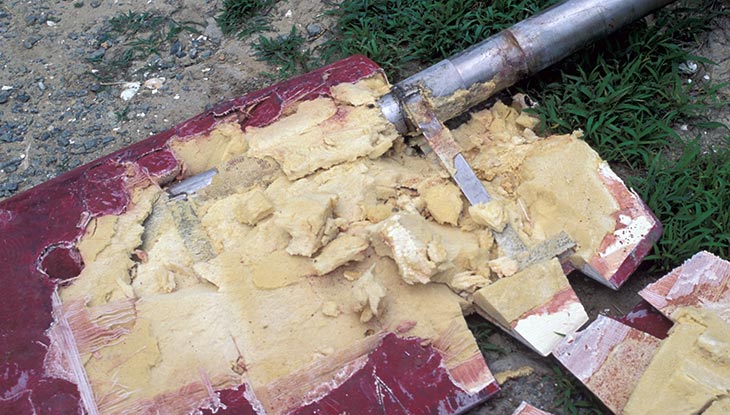
This destroyed foam-core and stainless-steel rudder reveals the conventional construction of such appendages.
Additionally, where possible, the stock should consist of a single section of solid or tubular material; i.e., it should not be sleeved, reduced, or otherwise modified or welded unless done so in an exceptionally robust manner. The webbing must be welded to the stock, but the structure of the stock should not rely on a weld that would experience cyclical, torsional loading.
The webbing in the form of a plate or grid should be welded to the stock with ample horizontal gussets (small wedges welded where the stock and webbing interface), which will reinforce welds 90° to the primary web attachment.
Whether the rudder is spade (supported only at the top) or skeg hung (supported at the top and the bottom), the stock must pass through and be supported by the hull. This is usually accomplished by a component known as a rudder log, or port. In its simplest form it’s a tube or pipe through which the stock passes. Nearly all logs incorporate two other components—a bearing and a stuffing box. The bearing may be as simple as a bronze or nonmetallic bushing or tube inside of which the stock turns; or it may be as complex as a self-aligning roller-bearing carrier that absorbs rudder deflection and prevents binding.
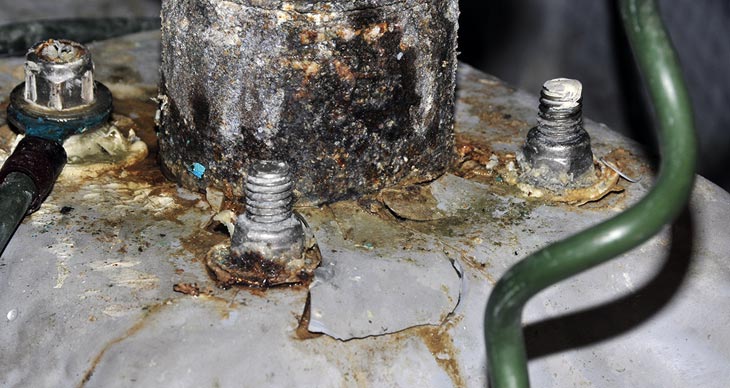
This rudder log is leaking, corroded, and poorly supported, with washers compressing into the backing plate and gelcoat cracking off.
The log transfers tremendous loads and must be exceptionally strong and well bonded to the hull. Fiberglass vessels should rely on a well-tabbed-in purpose-made tube (its filaments are wound and crisscrossed and thus quite strong) that is supported with a series of vertical gussets that distribute the load to the hull’s surrounding structure. On some spade rudder installations, particularly where the log is not, or could not, be long enough, an additional bearing is used at the top of the stock, above the quadrant, where it is supported by the vessel’s deck.
On metal boats the design is similar but with a metal tube welded in place, supported by substantial gussets. For vessels with skeg-hung rudders, the strength of the rudder log is still important. However, because the loads are not imparted by a cantilevered structure, logs used in these applications may be less substantially supported.
Stuffing Box
Unless the rudder log’s upper terminus is well above the waterline or on the weather deck, it is typically equipped with a stuffing box similar to those used for propeller shafts. But unlike a shaft stuffing box, the rudder’s stuffing box shouldn’t leak much, if any, seawater. Because the rudder turns slowly, friction and heat are not a problem. Packing (i.e., waxed-flax packing like that in traditional stuffing boxes) can typically be tight enough to stem all leakage, and lubricating it with heavy water-resistant grease will reduce friction and leakage.
Stuffing boxes that are above the waterline while the vessel is at rest, such as those on many sailboats, are often the most chronically leaky, because the packing tends to dry out and contract. To avoid this, liberally apply grease to the packing material itself; this requires partial disassembly of the stuffing box. Alternatively, a galvanically compatible (316 stainless or Monel for bronze stuffing boxes) grease fitting may be installed and periodically pumped with grease to keep the packing lubricated.
Rudder Bearings

Well-engineered rudder bearings support and lubricate the rudderstock.
Rudder bearings range from the basic rudderstock turning inside a bronze log, to the sophisticated aluminum, stainless, or nonmetallic roller bearings installed in a self-aligning carrier. For most cruising vessels, the choice of bearing is not as important as knowing which type of bearing is in use and its strengths, weaknesses, and maintenance needs. The simple shaft that turns inside a bronze log is durable and reliable but more friction-prone than roller bearings. If lubrication access or a grease fitting is available, it should be pumped with grease periodically, although most rudders rely solely on seawater for lubrication, which is perfectly acceptable.
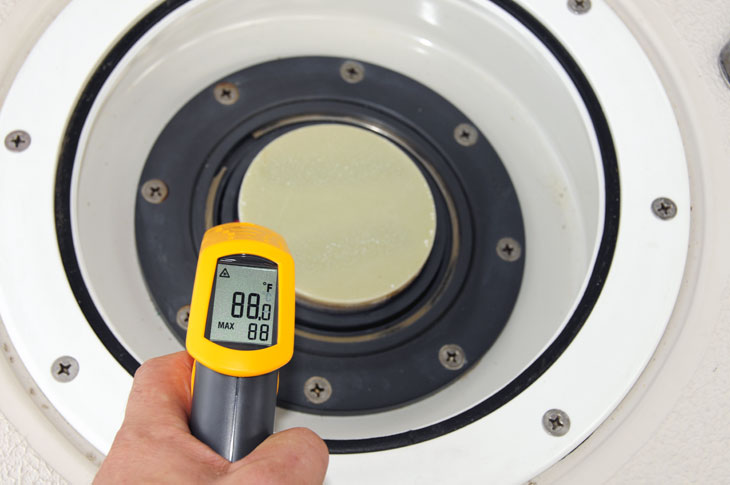
This synthetic upper bearing worked fine in cool temperatures, but when it heated up in the sun, the material expanded and caused binding in system.
Nonmetallic sleeve and roller bearings, often made of ultra high molecular weight polyethylene (UHMWPE), require no maintenance, are extremely slippery, and will not absorb water, an essential attribute for nonmetallic bearings. Delrin and nylon, for instance, will absorb water, expand, and lead to rudder binding. On several high-performance sailing vessels, I’ve had to replace nylon or similar bearings with UHMWPE to restore the steering to its proper specification and effort level.
Propeller Removal
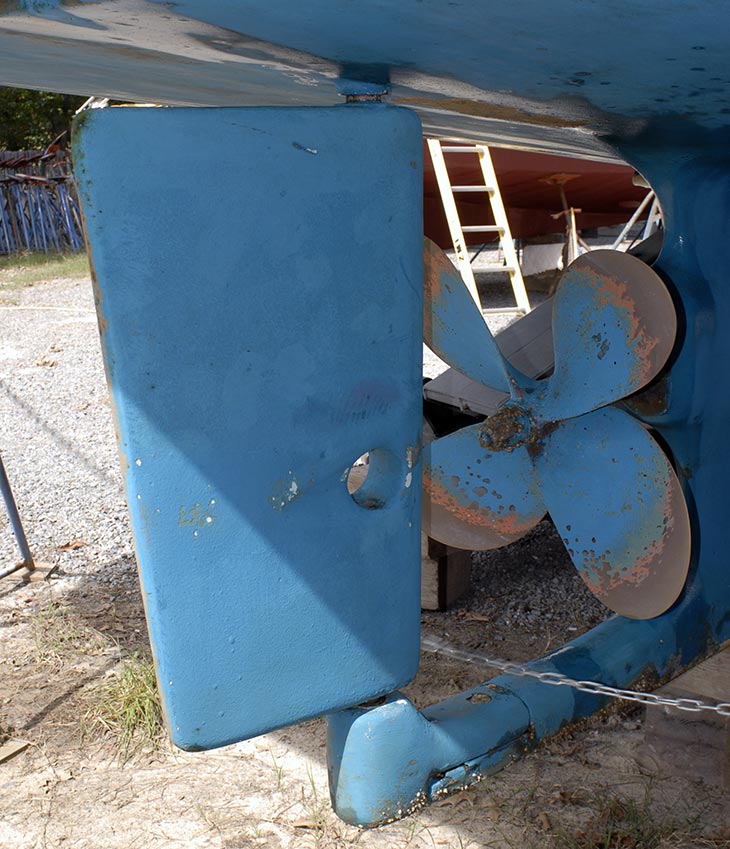
Shaft removal should be possible with the rudder in place. This conventional skeg-hung rudder has a hole to facilitate shaft removal when the rudder is swung hard to port or starboard.
Whether a rudder is a spade or skeg-hung design, it’s important to determine how it will affect the removal of the propeller or the propeller shaft. Is there enough clearance between the shaft’s trailing end and the leading edge of the rudder to allow the propeller to be removed or to use a propeller removal tool? Can the shaft be slid out without removing the rudder? Some rudders are equipped with shaft-removal holes, while others are installed slightly offset from the centerline; or the rudder’s leading edge has an indentation to allow the shaft to be removed. The propeller should be removable without having to unship the rudder. The dimensional rule of thumb calls for clearance of at least the prop’s hub length between the aft end of the shaft and the leading edge of the rudder.
Rudder Stops
The rudder’s movement should be unimpeded as it swings approximately 35° in either direction, making no contact with hull or propeller. Just as important as the rudder travel is how its movement is checked. Other than for the smallest runabouts with jacketed cables, all inboard rudders should rely on hydraulic cylinders to check rudder travel (provided they are designed to do so, and most are) or be equipped with robust stops. Stops must be integral to the hull, supported by substantial tabbing or a welded and through-bolted structure for fiberglass vessels, or by welded angle and shelves for metallic hulls.
About the Author: For many years a full-service yard manager, Steve now works with boatbuilders and owners and others in the industry as Steve D’Antonio Marine Consulting. He is an ABYC-certified Master Technician, and sits on that organization’s Hull and Piping Project Technical Committee. He’s also the technical editor of Professional BoatBuilder .
Read more Repair articles
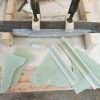
Quick Custom Molds
Making one-off composite parts in the shop.
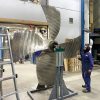
Repairing Bent Props with TrueProp Software
With all the advances in automation and electrification of boat propulsion systems, propellers remain critical to the task of converting power into propulsion. Made of bronze, nickel, aluminum, stainless steel,… Read more »
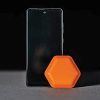
VacPuc Checks Your Vacuum Bags
It’s possible to monitor houses, cars, cats, and boats by smartphone, so why not check vacuum bags during resin infusion? Now composite technicians have this option with VacPuc, a new… Read more »

Recent Posts
- Candela’s Faith in Foiling Ferries
- Australia II Wing Keel Controversy – Part 2
- Australia II Wing Keel Controversy – Part 1
- Learn Electrical Systems from Nigel Calder
- PRO-SET Epoxy Named an Official Supplier for New York Yacht Club American Magic, Challenger for the 37th America’s Cup
- Companies (83)
- Construction (105)
- Design (159)
- Drawing Board (10)
- Education (24)
- Environment (16)
- Events (21)
- Materials (48)
- Obituary (17)
- People/Profiles (48)
- Products (16)
- Propulsion Systems (31)
- Racing (16)
- Repair (37)
- Rovings (314)
- Short Cuts (3)
- Sponsored Partner News (13)
- Systems (80)
- Task Sheet (1)
- Uncategorized (26)
- Wood to Glass (7)
ProBoat.com Archives
- Types of Sailboats
- Parts of a Sailboat
- Cruising Boats
- Small Sailboats
- Design Basics
- Sailboats under 30'
- Sailboats 30'-35
- Sailboats 35'-40'
- Sailboats 40'-45'
- Sailboats 45'-50'
- Sailboats 50'-55'
- Sailboats over 55'
- Masts & Spars
- Knots, Bends & Hitches
- The 12v Energy Equation
- Electronics & Instrumentation
- Build Your Own Boat
- Buying a Used Boat
- Choosing Accessories
- Living on a Boat
- Cruising Offshore
- Sailing in the Caribbean
- Anchoring Skills
- Sailing Authors & Their Writings
- Mary's Journal
- Nautical Terms
- Cruising Sailboats for Sale
- List your Boat for Sale Here!
- Used Sailing Equipment for Sale
- Sell Your Unwanted Gear
- Sailing eBooks: Download them here!
- Your Sailboats
- Your Sailing Stories
- Your Fishing Stories
- Advertising
- What's New?
- Chartering a Sailboat
- Sailboat Rudder
Making a Sailboat Rudder for s/y Alacazam
It's not enough just for a sailboat rudder to steer the boat effectively, it should also contribute to the keel's job of providing lift to windward, and for it to do this it must be designed as a hydrodynamic foil.
Of course a rudder doesn't have to provide lift, but it's a wasted opportunity if it doesn't.
As with an aircraft's wing, to develop lift the sailboat rudder must have water flowing over its leading edge at an angle of attack.
Fortunately for us sailors, the pressure of air on the windward side of the sails, pushes the boat bodily off course slightly and it's this leeway that provide the angle of attack - or angle of incidence- that enables our keels and rudders to provide lift.
But What Type of Sailboat Rudder would be Best for Alacazam ?
First, we considered twin transom-mounted rudders. The usual argument for twin rudders is:
- as the boat heels, the leeward rudder is more deeply immersed and provides better control, and
- the boat, resting on the keel and two rudders can dry-out upright.
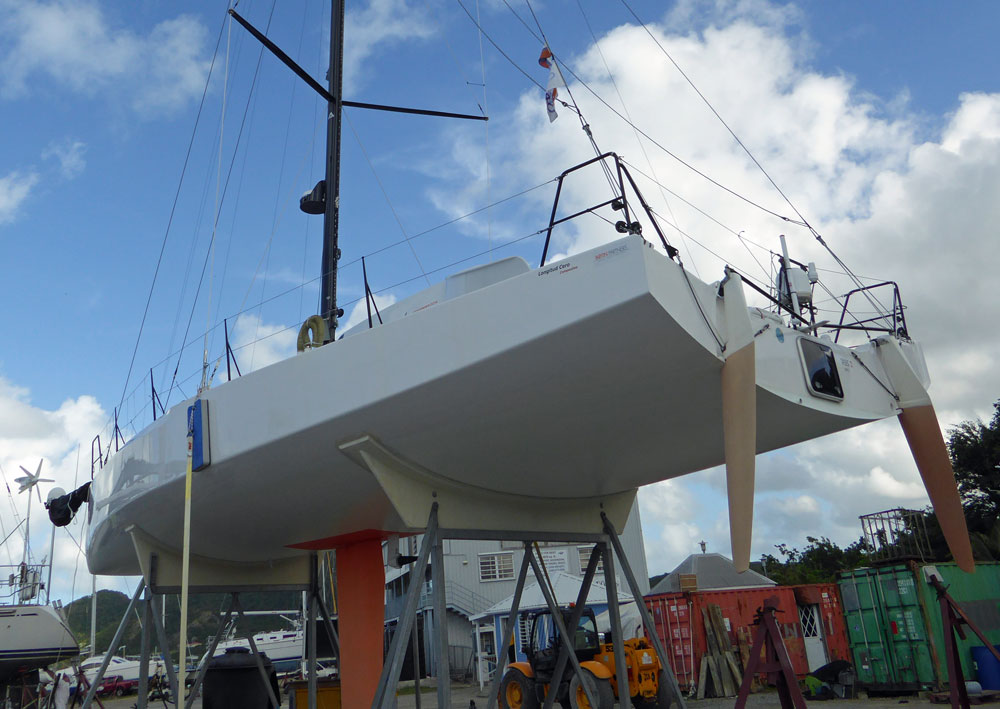
But in the end we decided against the twin rudder arrangement because:~
- with Alacazam's deep draught (7 feet, or 2.2m) the twin rudders wouldn't be deep enough to achieve the drying-out upright benefit, and
- the mechanical complexity of tiller steered twin rudder system went against one of our key design principles - keep it simple, and
- with no propwash flowing over the rudders, manoeuvring under power in tight situations would be a little too interesting for my tastes.
So the conventional single rudder approach it was to be. But what type of sailboat rudder?
A Transom-Hung Rudder
We liked the simplicity of this arrangement, but it didn't suit Alacazam's hull design at the stern. We wanted a sugar-scoop design with a bathing platform to allow easy access from the dinghy which ruled out a transom hung rudder. Similarly, it meant that mounting the servo-pendulum self-steering gear would be unnecessarily complicated.
Spade Rudder
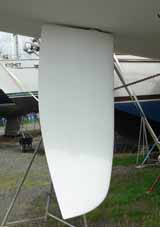
The spade rudder is the most efficient of all sailboat rudders, which is why you're unlikely to see any other design on racing yachts.
The absence of a skeg means that all of its area is used to apply a turning force to the hull, minimizing wetted area and associated drag.
The area ahead of the stock helps to balance the rudder, making life easier for the helmsman.
But it's not the most robust design, being entirely dependent on the strength of rudder stock to resist impact damage.
Theoretically it's just a matter of engineering, but high performance spade rudders just aren't thick enough to incorporate a rudder stock of sufficient diameter for ultimate security.
Skeg-Hung Rudder
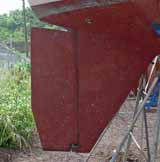
Other than those rudders hung on the following edge of long keels, the skeg hung rudder - supported top and bottom on a full length skeg - is the most robust design.
Without a portion forward of the stock, there's no balancing force to take the load of the helmsman's arms - so loads can be quite heavy in some designs.
Nevertheless, it's a very popular design for offshore cruising boats.
Semi-Balanced Rudder
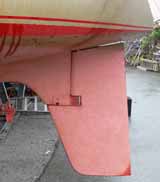
This design of sailboat rudder is something of a compromise between the spade rudder and the full skeg rudder.
Supported at its mid-point by a half-depth skeg, it benefits by the area forward of the stock, below the skeg.
This applies a balancing force as the rudder is turned making the steering lighter than it would otherwise be. And it was this design we chose for Alacazam's rudder.
Making Alacazam's Rudder

A typical productions boat's rudder is likely to have been fabricated as shown here, with two GRP mouldings 'clamshelled' around a foam core.
Not the most reliable arrangement you might think - and you'd be right.
We wanted something a little more robust for Alacazam's rudder.

But first, the rudder stock.
We fabricated this from a 2" (50mm) diameter stainless steel solid bar and welded on flat stainless tangs that would be embedded within the rudder.
The Admiralty Bronze casting will eventually connect the rudder to the skeg.
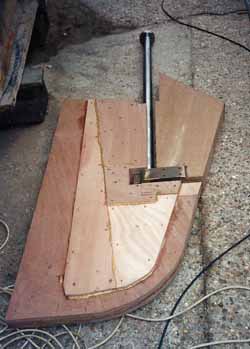
With the rudder stock fabricated, we began the construction of the rudder core.
It was made up from half inch (12mm) marine ply sheets, cut to shape and incorporating cut-outs for the tangs, screwed and glued together.
The rudder and skeg was built up as a single unit at this stage.
The rudder design software generated coordinates for various stations along the rudder, and we used these to cut templates so that we could get the shape right.
Shaping the rudder profile was done by hand, initially with a plane to remove the excess, then with a file and diminishingly coarse grades of sandpaper.
Once the rudder profile matched the appropriate template we removed the section that would form the skeg.
Next, the rudder was fitted to the stock with any gaps between the tangs and the ply taken up with high-strength epoxy 'gloop'.
Finally both the rudder and the skeg were sheathed in several layers of epoxy-glass rovings before being filled and faired with epoxy fairing compound.
Fitting the Sailboat Rudder
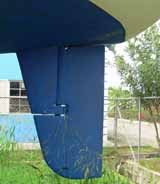
The skeg was letter-boxed through a slot cut in the hull, securely braced internally and bonded to it with fillets of high-strength epoxy and epoxy glass rovings.
Inside the hull we had constructed a GRP tube to contain the stock, and the skeg was also bonded to the lower end of that.
The rudder was then securely fitted to the stock via the bronze bearing, and located at the top of the rudder by a stainless steel bearing.
That's it, we now have a very robust and efficient rudder securely attached to Alacazam's hull.
Recent Articles
'Natalya', a Jeanneau Sun Odyssey 54DS for Sale
Mar 17, 24 04:07 PM
'Wahoo', a Hunter Passage 42 for Sale
Mar 17, 24 08:13 AM
Used Sailing Equipment For Sale
Feb 28, 24 05:58 AM
Here's where to:
- Find Used Sailboats for Sale...
- Find Used Sailing Gear for Sale...
- List your Sailboat for Sale...
- List your Used Sailing Gear...
Building Alacazam...
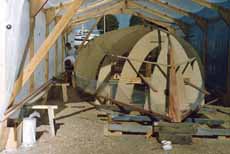
But why go to the bother of building your own boat?
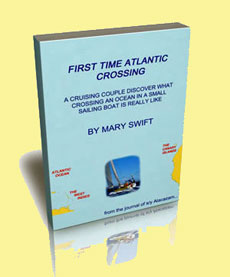
Copyright © 2024 Dick McClary Sailboat-Cruising.com
- New Sailboats
- Sailboats 21-30ft
- Sailboats 31-35ft
- Sailboats 36-40ft
- Sailboats Over 40ft
- Sailboats Under 21feet
- used_sailboats
- Apps and Computer Programs
- Communications
- Fishfinders
- Handheld Electronics
- Plotters MFDS Rradar
- Wind, Speed & Depth Instruments
- Anchoring Mooring
- Running Rigging
- Sails Canvas
- Standing Rigging
- Diesel Engines
- Off Grid Energy
- Cleaning Waxing
- DIY Projects
- Repair, Tools & Materials
- Spare Parts
- Tools & Gadgets
- Cabin Comfort
- Ventilation
- Footwear Apparel
- Foul Weather Gear
- Mailport & PS Advisor
- Inside Practical Sailor Blog
- Activate My Web Access
- Reset Password
- Pay My Bill
- Customer Service

- Free Newsletter
- Give a Gift

How to Sell Your Boat

Cal 2-46: A Venerable Lapworth Design Brought Up to Date

Rhumb Lines: Show Highlights from Annapolis

Open Transom Pros and Cons

Leaping Into Lithium

The Importance of Sea State in Weather Planning

Do-it-yourself Electrical System Survey and Inspection

Install a Standalone Sounder Without Drilling

When Should We Retire Dyneema Stays and Running Rigging?

Rethinking MOB Prevention

Top-notch Wind Indicators

The Everlasting Multihull Trampoline

How Dangerous is Your Shore Power?

DIY survey of boat solar and wind turbine systems

What’s Involved in Setting Up a Lithium Battery System?

The Scraper-only Approach to Bottom Paint Removal

Can You Recoat Dyneema?

Gonytia Hot Knife Proves its Mettle

Where Winches Dare to Go

The Day Sailor’s First-Aid Kit

Choosing and Securing Seat Cushions

Cockpit Drains on Race Boats

Rhumb Lines: Livin’ the Wharf Rat Life

Re-sealing the Seams on Waterproof Fabrics

Safer Sailing: Add Leg Loops to Your Harness

Waxing and Polishing Your Boat

Reducing Engine Room Noise

Tricks and Tips to Forming Do-it-yourself Rigging Terminals

Marine Toilet Maintenance Tips


Learning to Live with Plastic Boat Bits
- Boat Maintenance
Building a Faster Rudder
Boost performance with a bit of fairing and better balanced helm..
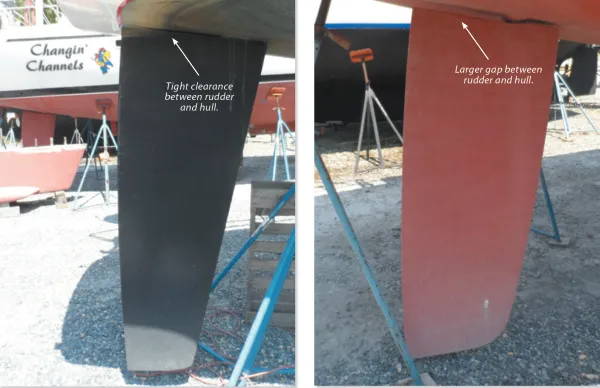
We’re cruisers not racers. We like sailing efficiently, but we’re more concerned with safety and good handling than squeezing out the last fraction of a knot. Heck, we’ve got a dinghy on davits, placemats under our dishes, and a print library on the shelf. So why worry about perfection below the waterline?
The reason is handling. A boat with poorly trimmed sails and a crudely finished rudder will miss tacks and roll like a drunkard downwind when the waves are up. On the other hand, a rudder that is properly tuned will agilely swing the boat through tacks even in rough weather, and provide secure steering that helps prevents broaching when things get rolly. The difference in maximum available turning force between a smooth, properly fitted rudder and the same rudder with a rough finish and poor fit can be as much as 50% in some circumstances, and those are circumstances when you need it the most. It’s not about speed, it’s about control.
It Must Be Smooth
Smooth is fast. That’s obvious. But it makes an even bigger difference with steering. Like sails, only half of rudder force comes from water deflected by the front side of the blade. The rest results from water being pulled around the backside as attached flow. How well that flow stays attached is related to the shape of the blade, which we can’t easily change, and to the surface finish of the blade, which we can.
Remember the school experiment, where you place a spoon in a stream of water and watched how the water would cling to the backside of the spoon? Now, try the experiment again as a grown-up, but with a different set of materials.
Try this with a piece of wood that is smooth and one that is very rough; the water will cling to the smooth surface at a greater angle than the rough surface. Try piece of smooth fiberglass or gelcoat; the water will cling even better because the surface is smoother. Try a silicone rubber spatula from the kitchen. Strangely, even though the surface is quite smooth, the water doesn’t cling well at all. We’ll come back to that.
Investigators have explored this in a practical way, dragging rudders through the water in long test tanks (US Navy) and behind powerboats.
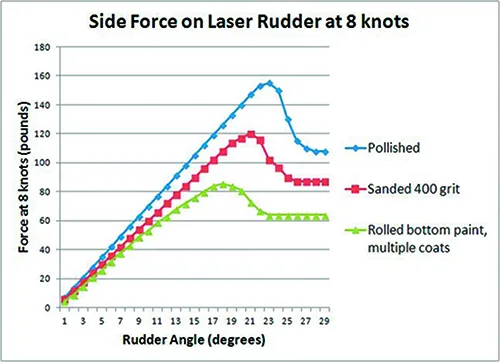
If we are trying to climb to windward, it’s nice to get as much lift out of the rudder as practical, before drag becomes too great or before it begins to stall with normal steering adjustments. If the boat has an efficient keel and the leeway angle is only a few degrees, the rudder can beneficially operate at a 4-6 degree angle. The total angle of attack for the rudder will be less than 10 degrees, drag will be low, and pointing will benefit from the added lift. If the boat is a higher leeway design—shoal draft keels and cruising catamarans come to mind—then the rudder angle must stay relatively low to avoid the total angle (leeway + rudder angle) of the rudder from exceeding 10 degrees. That said, boats with truly inefficient keels but large rudders (catamarans have two—they both count if it is not a hull-flying design) can sometimes benefit from total angles slightly greater than 10 degrees—they need lift anywhere they can get it.
How can you monitor the rudder angle? If the boat is tiller steered, the tiller will be about 0.6 inches off center for every degree or rudder angle, for every 3 feet of tiller length. In other words, the 36-inch tiller should not be more than about 2 inches off the center line. If the boat is wheel steered, next time the boat is out of the water, measure the rudder angle with the wheel hard over. Count the number of turns of the wheel it takes to move the rudder from centered to rudder hard over, and measure the wheel diameter. Mark the top of the rim of the wheel when the boat is traveling straight, preferably coasting without current and no sails or engine to create leeway.
The rim of the wheel will move (diameter x 3.146 x number of turns)/(degrees rudder angle at hard over) for each degree of rudder angle. Keep this in the range of 2-6 degrees when hard on the wind, as appropriate to your boat. It will typically be on the order of 4-10 inches at the steering wheel rim. A ring of tape at 6 degrees can help.
How do we minimize rudder angle while maintaining a straight course? Trimming the jib in little tighter or letting the mainsheet or traveler out a little will reduce pressure on the rudder and reduce the angle. Some boats actually sail to weather faster and higher, and with better rudder angles, by lowering the traveler a few inches below the center line.
On the other hand, tightening the mainsheet and bringing the traveler up, even slightly above the center line on some boats, will increase the pressure and lift.
Much depends on the course, the sails set, the rig, the position of the keel, the wind, and the sea state. Ultimately, some combination of small adjustments should bring the rudder angle into the appropriate range. Too much rudder angle and you are just fighting yourself.
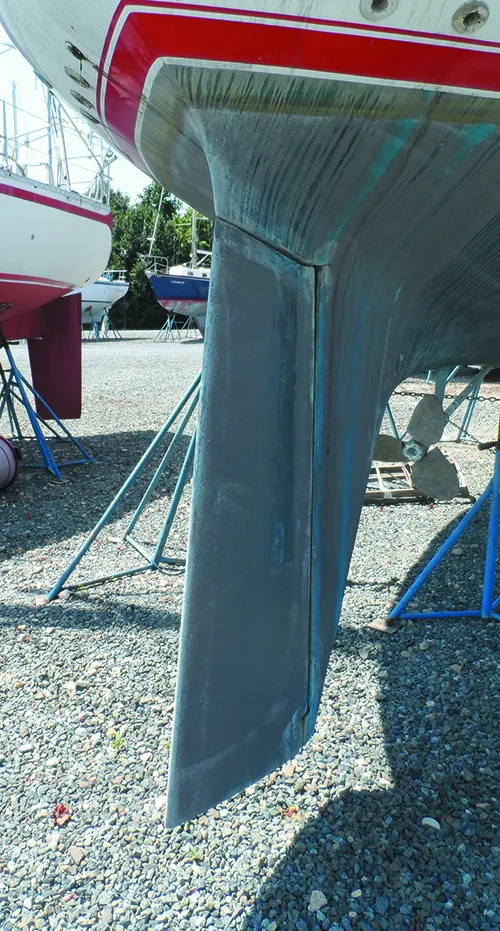
- Turn this rudder just 10 degrees and the end plate is lost, reducing the amount of lift generated.
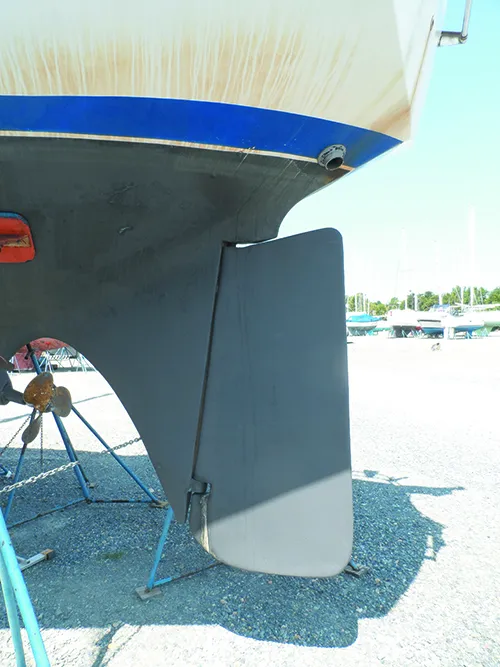
- This rudder might as well be transom hung, the way that the end cap just disappears.
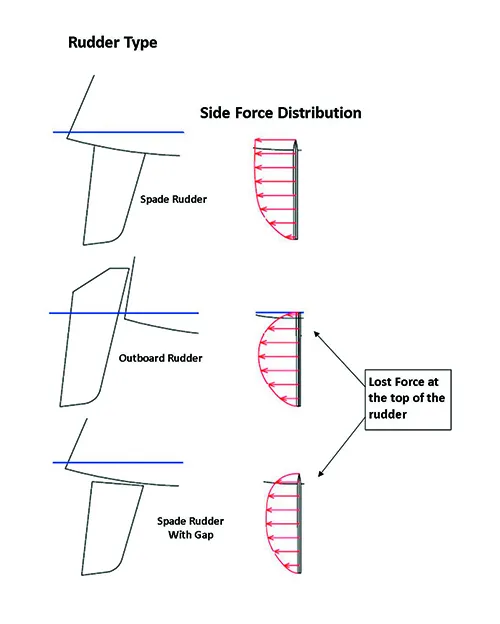
- Stern-hung rudders, and spade rudders with large gaps between the hull and the top of the rudder will lose their lift at the “tip” of the blade near the surface.
Surface roughness affects the lift from the rudder in two ways. A rougher surface has slightly lower lift through the entire range of angles, the result of a turbulent boundary layer instead of smooth flow over the entire surface. More dramatically, rougher blades stall at lower angles and stall more completely. The difference between a faired rudder with a polished finish and a rudder carrying a 10-year accumulation of rolled-on antifouling paint can be as much is 35 percent (see “Rudder Savvy to Boost Boat Performance,” above).
What can we do? If your rudder is a lift up type, don’t use bottom paint. Fair the blade within an inch of its life and lay on a gloss topside paint as smoothly as possible, sanding between coats. If you use a brush, stroke the brush parallel to the waterline, not along the length of the blade.
Which is faster, a gloss finish or one that has been dulled with 1000 grit sandpaper? Opinions go both ways, and we believe it may depend on the exact nature of the paint, which leads to the question, “Should we wax the blade?” The answer is a resounding, no.
Wax is a hydrophobic (readily beads water), like the silicone rubber spatula you tested, and as a result, water doesn’t always cling as well. Thus, whether the paint should be deglossed or not depends on the chemistry of the paint, but in all cases the final sanding should be 1000 grit or finer.
If the rudder stays in the water, antifouling paint is required. Sand the prior coat perfectly smooth. There should be no evidence of chips, runners, or any irregularity at all. Using a mohair roller, lay the paint on thin, and apply multiple coats to withstand the scrubbing you will give your rudder from time to time.
Even if you use soft paint on the rest of the boat, consider hard paint for the rudder. Sure, it will build up and you will have to sand it off periodically, but the rudder is small and no part of your boat is more critical to good handling. Take the time to maintain it as a perfect airfoil.
Close the Gap
Ever notice the little winglets on the tips of certain airplanes? As we know, those are intended to reduce losses off the tip of the wing. The alternatives are slightly longer wings or slightly lower efficiency. At the fuselage end of the wing, of course, there is no such loss because the fuselage serves as an end plate. The same is true with your rudder.
There’s not much you can do about losses from the tip; making the rudder longer will increase the chance of grounding and increase stress on the rudder, rudder shaft, and bearings. Designers have experimented with winglets, but they the catch weeds and the up-and-down motion of the transom makes them inefficient. However, we can improve the end plate effect of the hull by minimizing the gap between the hull and the rudder.
In principle it should be a close fit, but in practice the gap is most often wide enough to catch a rope. Just how much efficiency is lost by gap of a few inches? The answer is quite a lot. A gap of just an inch can reduce lift by as much as 10-20 percent, depending on the size and shape of the rudder and the speed. A gap of 1-2 mm is quite efficient, but normal flexing of the rudder shaft may lead to rubbing.
If the gap is tight, the slightest bend from impact with a submerged log can cause jamming and loss of steering, though in my experience once the impact is sufficient to bend the shaft, a small difference in clearance is unlikely to make much difference; the shaft will bend until the rudder strikes the hull. Just how tight is practical depends on the type of construction, fitting accuracy, and how conservative the designer was in their engineering.
Carbon shafts, tubular shafts, and rudders with skegs flex less, while solid shafts generally flex more, all things being equal. Normally a clearance of about 1/4-inch per foot of rudder cord is practical, and performance-oriented boats often aim for much less. If you can reach your fingers through, that’s way too much. Hopefully the hull is relatively flat above the rudder so that the gap does not increase too much with rudder angle.
Practical Sailor’s technical editor Drew Frye is the author of the books Keeping a Cruising Book for Peanuts and Rigging Modern Anchors. He blogs at his website, sail delmarva.blogspot.com .
RELATED ARTICLES MORE FROM AUTHOR
21 comments.
How happy to see good technical information about the science of boat speed and control. This information is valuable to everyone, but the “mainly just cruising” cohort usually doesn’t get enough in an easily understandable form. I always suggest some club level racing as the best way to learning how to sail, but many prospective racers have been put off from the sport or haven’t had good opportunities to join the fleets. Technical seminars are generally either too advanced for beginners to understand properly, and the beginner classes are frequently too basic to inspre those who would benefit from a deeper knowledge base in the science of sailing. Good on you, Practical Sailor, for your technical stories hitting the “sweet spot,” getting this information to those we’ll benefit most.
Great article. How about considering modifying a rudder to make it a hydrodynamically balanced rudder. I did it to my boat and the difference is outstanding. If I remember correctly 7% of the rudder area is forward of pivot center. It is a skeg hung rudder that now turns like it’s a spade rudder.
I’m “skeg hung” also. Would you be so kind as to posting a link or providing info as to you accomplished this feat. Thanks!
A very clear explanation of some quite complicated hydrodynamics – thank you! I am surprised by the US Navy results showing benefit of sanding further than 400 grit. Most other experimental data suggest there is negligible advantage in going beyond about 360 grit. Is the original reference publicly available? On Michael Cotton’s comment, a couple of points: Firstly, the amount of balance (i.e how far back you put the stock in the blade) has no impact on the hydrodynamic performance of a spade rudder. What it does do is change the feel of the rudder; a well balanced rudder will be easier to use, thereby probably allowing the steerer to sail the boat better. For a skeg rudder, the hydrodynamic impact of changing the balance depends very much on how the skeg/blade combination is configured. Secondly, 7% of rudder area forward of the stock is not enough for most rudders. The position of the centre of pressure is dependent on a lot of factors (aspect ratio, rudder angle etc.), but it is usually at least 15% back from the leading edge on a spade rudder, more often 20%. A balance somewhere between 10% and 15% is likely to give just enough feel without too much weight. However, rudder balance is still a bit of a black art, it really does depend on the rudder geometry.
the statement that one doesn’t want a silicone/silane coated ( super-smooth, hydrophobic: silicone-silane is just the example I am choosing, since it is now in use as a massively-speeding hull-coating, ttbomk ), as it *induces* flow-separation…
looks to me like conflating cavitation with flow-separation.
People have no problem teflon/ptfe-coating aviation-wings, as a means of *preventing* flow-separation.
the super-slick shape of a Cirrus’s composite wing, if made super-smooth/polished & super-slippery, “air-phobic”, as it were, *improves* its performance, not detracts from it….
Flow is always 1. laminar, then 2. turbulent, then 3. flow-separation.
unless the angle-of-attack ( AoA ) is small-enough to prevent separation.
The Gentry Tufts System, for *seeing* when a separation-bubble begins, on a sail, is brilliant ( Arvel Gentry was a fluid dynamicist, & realized that once one has a *series* of tufts, from luff on back, about 1/4 up the luff, one can *see* the beginning of a flow-separation-bubble, & tune the sail to keep it *just*-beginning, because *that* is MAX lift. Wayback Machine has his site archived, btw )
The aircraft designer Jan Roskam wrote of a DC-10 crashing because pebbled-ice as thick as the grit on 40-grit sandpaper had formed on the upper wings…
obviously, engineered to require laminar, there, but having turbulent, cost all those lives.
iirc, it was Arvel Gentry, or “Principles of Yacht Design”, that stated it takes a ridge of about 0.1mm, only, to trip the flow around a mast from laminar to turbulent…
Given how barnacles & such are generally 100x or more as thick as that, when removed from a hull, I think laminar-flow is something that exists only for the 1st day or so after launching!
I now want to see experiment showing polar curves for rudders coated normally, uncoated, & ailicone-silane coated, to see if it is the coating that induces separation-bubbles, or if it is AoA exceeding functional angle, for that surface & foil,, while the boundary-layer is in specifically turbulent flow, as opposed to the ideal laminar, as aviation’s results indicate…
just an amateur student of naval-architecture & aircraft-design ( Daniel P. Raymer’s “Conceptual Aircraft Design” is *brilliant*, btw ), who happens to study this stuff autistically, as that is the only way to make my designs become absolutely-competent, is all…
I got a pearson and the rudder broke. Can I just replace with a outboard rudder mount it off set for room for outboard need info.
You could but it will not work very well. How badly it would perform is difficult to say. It might be just poor or disastrous. Things really need to be balanced on sail boats.
Polished rudders stall at low angles of attack and ask any hobie cat racer.
Pi is NOT 3.146
3.1416 maybe
Yup, 3.1416. Typo.
Before 2005 , when I fully retired and went cruising 10 months per year, I changed auto pilots, the hydraulics of which reduced the maximum rudder angle. “Someday” had always been difficult to steer in marinas, so I added 30% more rudder area to the Gulfstar 41′ by deepening and following the existing angles. (the pivot was unchanged, as all added area was aft of that.) It increased rudder effort noticeably, but not excessively, improved motor maneauvering and allowed being able to hold a close line better. Noticeably, it caused a lot more stalling of the rudder whenever it was turned very much. A recent tangle with a Guatemala fish net damaged the extension, which I had intended to be sacrificial. I cleaned up the separation somewhat, but have not replaced the extension. The boat again now requires more steering correction when heading at all upwind, but the rudder does not stall as easily.
This is not a scientific study, just my personal non-scientific observations. The added rudder area was quite low, and the fairing quality was…well! modest.
I’ve seen data suggesting ~ 400 grit is best, and I’ve seen data suggesting polished is best. They were both smart, respected guys that I would not second guess. My conclusion is that other factors, such as the specific foil profile and the type of coating, are involved. Let’s just agree that many layers of rolled bottom paint with a few lumps and chips is sub-optimal! We’re talking about cruising boats.
Thanks for great article. I’m convinced enough to go sand my bottom paint off the lifting rudder of my Dragonfly Tri.
Absolutely! No lifting rudder should have bottom paint. My Farrier rudder was sanded fair and painted with gloss white.
Dagger boards and center boards that retract still need antifouling, since they do not lift clear of the water, but because they are in a confined space with little oxygen or water flow, fouling is very limited. Because the space is tight and paint build-up can cause jamming, sand well and limit the number of coats. For my center board I go with two coats on the leading edge (exposed even when lifted) and one coat on the rest.
I do remember a comment directed to cruisers a few years back suggesting that a faster cruiser would be more likely to get out of the way of dirty weather, especially with modern forecasting. I reckoned that this concept would gain traction, but I haven’t seen it. Can anyone weigh in on this opinion?
As interesting as the article reads, I wonder how it helps a prospective buyer of a used boat. Pictures will not do, and neither will taking several boats out of the water to examine them; it’s too expensive. It would be more helpful to indicate which boat manufacturers have the type of rudder the author recommends. After all, the buyer usually cannot be expected to change a rudder prior to buying it; it is also expensive. By the way, these types of very sophisticated articles are seen when it comes to hulls, keels, or rigging but without identifying the boats that carry the wrong equipment. If a specific rudder or keel configuration is not the proper one for efficient sailing, the author ought to state which boats carry the proper ones so that the buyer will concentrate on the whole (the boat) rather than the part.
I was describing the opportunity to improve the existing rudder. As I think back, I have modified the rudder of every boat I have owned in order to improve efficiency. The first two got small changes in balance and improved trailing edge sharpness. On the third I tightened the the hull clearance and changed the section. On my current boat I adding an anti-ventilation fence to improve high speed handling. https://4.bp.blogspot.com/-2ZGPzKdj_tE/WyF9G2mHtLI/AAAAAAAAOwE/r6zgQEr4vkcDB4ciMLcgboFdazDAseDBgCLcBGAs/s1600/ian%2Brudder%2Bfence.jpg None of these tasks was overly difficult, and none was undertaken until I had sailed the boat for a season and learned what balance she liked and noted her habits.
For me, I buy a boat based on reputation, a test sail, and in most cases, a survey. As you imply, it is the whole boat you are buying. Does it have good bones? Do you feel happy at the helm? Then comes the fine tuning. I’ve been told that I sell a boat when I run out of things to tweak.
wow, so now case reports/medical reports/evidence don’t count as “evidence”, but certain remedies, even if they are cited in medical journals but do not work in the real world, count as evidence to you?? Maybe we need to redefine evidence based on your philosophies.Anyway, i’ve wasted enough time here. goodbye.
Weight 2.5 tonnes
Do you have any articles on the ideal cross section shape for an outboard rudder mounted 50mm from the transom vertically The yacht is a 26 ft trailer sailer weight 2.5 tonnes
The most common choice would be NACA 0012. http://airfoiltools.com/airfoil/details?airfoil=n0012-il
There are many ways to build a rudder, including laminated solid rot-resistant wood and fiber glass covered foam with a metal armature core. For the DIY, laminated wood is probably the most practical.
LEAVE A REPLY Cancel reply
Log in to leave a comment
Latest Videos

Bahamas Travel Advisory: Cause for Concern?

Island Packet 370: What You Should Know | Boat Review

How To Make Starlink Better On Your Boat | Interview

Catalina 380: What You Should Know | Boat Review
- Privacy Policy
- Do Not Sell My Personal Information
- Online Account Activation
- Privacy Manager

What Is A Rudder On A SailBoat and How Does It Work ?

You’ve seen the helm of a sailboat and heard people talk about the rudder, but what exactly is it? The rudder on a sailing boat is a device that steers the ship. On smaller boats, like dinghies or kayaks, this steering might be done with oars or paddles. But on larger vessels, you will see that there are two vertical boards called blades (or rudders) attached to either side of the sternpost at its base. These blades can pivot from side to side so they allow the boat to turn in any direction needed when steering by hand.
Rudders are basically the underwater parts of your boat that controls your direction.It is tough to maintain the steering without them, so, they are one of the most critical parts of your boat. Different types of rudders with various features make the boat work differently. Do you want very high performance but a fragile rudder? Do you want a good performance, however, a well-protected rudder? It all depends on where you sail, how you sail, and what you would be willing to compromise. This blog post will explain what a rudder is, how it works, what kind of rudder designs are available out there.
Table of Contents
- 1 Tiller or Wheel?
- 2 So what is a rudder?
- 3 How rudder works?
- 4 Rudder types on Sailbaots
- 5 Conclusion: It's like most things in life; it's a compromise
Tiller or Wheel?

Tiller : Smaller boats (under 30 ft) usually use a tiller to turn the rudder. Tiller is basically a wooden (sometimes aluminium or steel) stick attached to the top of the rudder rod. The more force needed to turn it is better to make the tiller longer to increase the moment arm. They are great for racing and also for solo sailing as you don’t need to stand to control and you can also be busy with other things like tacking while holding the tiller between your legs.
Wheel : The bigger boats usually have wheel instead of tillers. The wheel system works with additional shafts and gears to ease the movement of the rudder blade. Wheel also gives the sense of driving as the turning direction is the same as the boat turning direction, unlike the tiller.
So what is a rudder?

The rudder designs we are using today have evolved from the steering board that was used in ancient times. The steering board was usually mounted on the right-hand side to suit right-handed sailors. In time the steering board moved on to the centre line through a stock passing through the vessel, and a tiller was then attached to the stock, which allows sailors to control the rudder from the main deck. Surprisingly the rudder basics are kept the same over the years. A tiller or wheel connected to a rudder stock connects to a board/blade in different shapes and profiles that create the lift under the water.
How rudder works?

The rudder works by deflecting water flow. When the rudder blade is straight and parallel with the flow, it has no effect on the steering.

When the skipper turns the rudder this is what happens;

If the rudder blade is directed to another angle, the blade has to direct the water at an angle away from the boat to increase the pressure on narrowed angle side and decrease the pressure on the other side.

This pressure difference pushes the stern to the low-pressure direction. In this case, the boat will try to turn to the port side. This is basically how you steer a sailboat with the rudder. Not an easy task to master but fun nevertheless!
Rudder types on Sailbaots

Rudder on a Full-keel sailboat
Full-keel boats or modified full keel boats usually have this type of Rudder. These rudders are typically hinged to the aft edge of the keel to make a continuous surface, not to create any drag after the main keel. Engine propeller is usually positioned between the keel and the Rudder.
The main advantage of these type of rudders is the Rudder is well protected and strong. It is hinged at the top and bottom, which helps distribute the forces on the rudder blade through the keel. Also, Rudder or any other item cannot snag on. In case of grounding, the Rudder will always be protected. This means you will be able to maintain your steering even after grounding or an accident.
Because of design, this type of Rudder requires more considerable forces to move, significantly when speed is increased. This is the reason why old long boats rarely have tillers as it usually requires a lot of push.
Manoeuvrability is more rigid on these type of rudders as the propeller wash effect can be so little – especially with the full keel attached rudders with a propeller notch. But hey, full keel boat itself is another challenge for manoeuvring, right?
Spade rudder and balanced spade rudder
Today, most fin keel boats have a spade rudder which is basically an extension straight down from the aft hull suction. The rudder rod comes down through the hull into the rudder blade itself in a most efficient and force friendly way. It allows the entire Rudder to rotate around.
Excellent performance: Spade rudders are modern rudders often chosen by serial production boats by famous brands. They are usually tall and thin, which gives high aspect ratios that means a lot of lift and little drag as the longer the Rudder is, the bigger the drag is.
Less force: They don’t need a full keel or Skeg for mounting. As the rudder blade can be moved around a balanced rod, the forces are much less than the other rudders.
Fragile : As it is applicable for any optimum design, more performance means less durability. A spade rudder is a vulnerable rudder, especially to debris or objects in the water which can hit the Rudder and exert a force on the rudder rod, which is the only structural support. Even the water pressure when the sailboat falls off a wave can have a significant impact on the rod and create high stresses. If the rod is bent, the Rudder may also jam – so be aware!
Balanced spade rudder: In some designs, the rudder rod and the leading edge of the rudder blade are arranged in the most optimum way, so the forces during the steering are as less as possible. These balanced spade rudders usually have a slight gap between the hull and the rudder blade.
Skeg mounted Rudder
Some fin keel boats also may have Skeg mounted rudders. It is a compromise version between the two rudder types above.
In general, Fin keel boats give more performance comparing to the full keel or modified full keel sailboats. When the Rudder is placed more to the aft that gets more clean water, it will have better performance; however, you may have durability issues, as explained in the spade rudder section.
Designers over the years combined these two rudder types and came up with a solution called skeg mounted rudder .
Some designs include skeg construction right before the rudder blade. They also call it cruisers rudder . The idea is the Skeg (faux keel), which is firmly attached to the hull or part of it like the keel, protects the Rudder for any damage and provides a better connection in terms of the load distribution loaded. As you might guess, you give up little performance for better durability.
It has the same advantages and disadvantages when you compare it with the full keel rudder or spade rudder; however, it is known that the forces on the helm can be on the high side. This means it requires more power to turn the rudder blade, especially in heavy weather or high speed.
Outboard Rudder
The outboard rudders are mounted outside the hull on the boat’s stern (transom) with the hinges. The outboard rudders are usually provided with a tiller instead of a wheel as there is no rudder rod to control with any gears.
Outboard rudders don’t need any hole through the hull, which is excellent in case of damage. The Rudder can be removed or serviced while the boat is still in the water. Also, the strong hinges from the top and bottom (sometimes in the middle) provide great strength, like in the full keel rudders.
Like the spade rudders, outboard rudders are vulnerable to any object that may hit. The forces on the helm will also be high at high speeds during sharp turnings.
It can also be dangerous when docking the sailboat from the aft side as you may hit the Rudder itself to the shore.
Conclusion: It's like most things in life; it's a compromise
The type of Rudder on a sailboat has more to do with the keel than any other equipment on the boat. As I said, if you are a day sailor and like the high performance and even participating in races, you wouldn’t go for a full keel sailboat. If you are a cruiser and making long passages and want to feel comfortable, then a full keel reliable boat might be your choice. Whatever the rudder and skeg configuration, it is essential that the keel has a more significant draft than the Rudder and/or Skeg. This way, in the event of a severe grounding, the keel takes the hit. We have seen new rudders that actually have more draft than the boat’s keel; this is absurd! In the event of a grounding, and if the boat dries out, the keel and Rudder must be built strong enough to support the boat’s total weight without damage and in a relatively stable manner. For this to occur, there must be a reasonable surface area on the bottom of the keel (a bulb keel does well here, as in so many other areas), with a flat or nearly flat profile far enough forward and aft of the boat’s centre of gravity to stop the boat toppling over on its ends if, for example, it is laid up against a jetty. However, a wide, flat keel is undesirable (some wing keels fall into this category). If the boat runs aground parallel to a steeply sloping shoreline with the tide going out, it will want to lie down on the “downhill” side. This will lay it over far more than if laid down on the “uphill” side and exacerbate problems such as stowed gear falling around and wet-type batteries leaking. It also makes the boat vulnerable to flooding when the tide comes back in, particularly if any seas are running.
Sharing is caring!

Lisa Hayden-Matthews
- May 8, 2021
- No Comments
Related Posts
Popular pontoon boat accessories you would be sorry to not have., 30 pontoon decoration & party ideas for a boat parade, how much do jet skis weigh (you would be surprised), how long does it take to learn to sail (not as long as you probably think), how to surf : everything you need to know.
Subscribe To Our NewsLetter!
FINANCIAL & MEDICAL DISCLOSURE
The HobbyKraze is a participant in the Amazon Services LLC Associates Program, an affiliate advertising program designed to provide a means for website owners to earn advertising fees by advertising and linking to amazon.co.uk and any other website that may be affiliated with Amazon Service LLC Associates Program. As their Associate, we earn from qualifying purchases.
The information written on this website is not medical advice, nor has it been endorsed by medical health professional(s). All content on this site is for informational purposes only.
We are independently owned and the opinions expressed here are our own
453, S Spring Street, Ste 400 PMB1061
Los Angeles, CA 90013
Accounts Dept : [email protected]
General Enquiries: [email protected]
Publishers Relations: [email protected]
Tel: +1 (213) 457-3776
Explore The World, Unleash Smart Hobbies & Increase The Zest For Life In You!
Site Structure EarthlyChirp
©2023 HobbyKraze. All Rights Reserved.
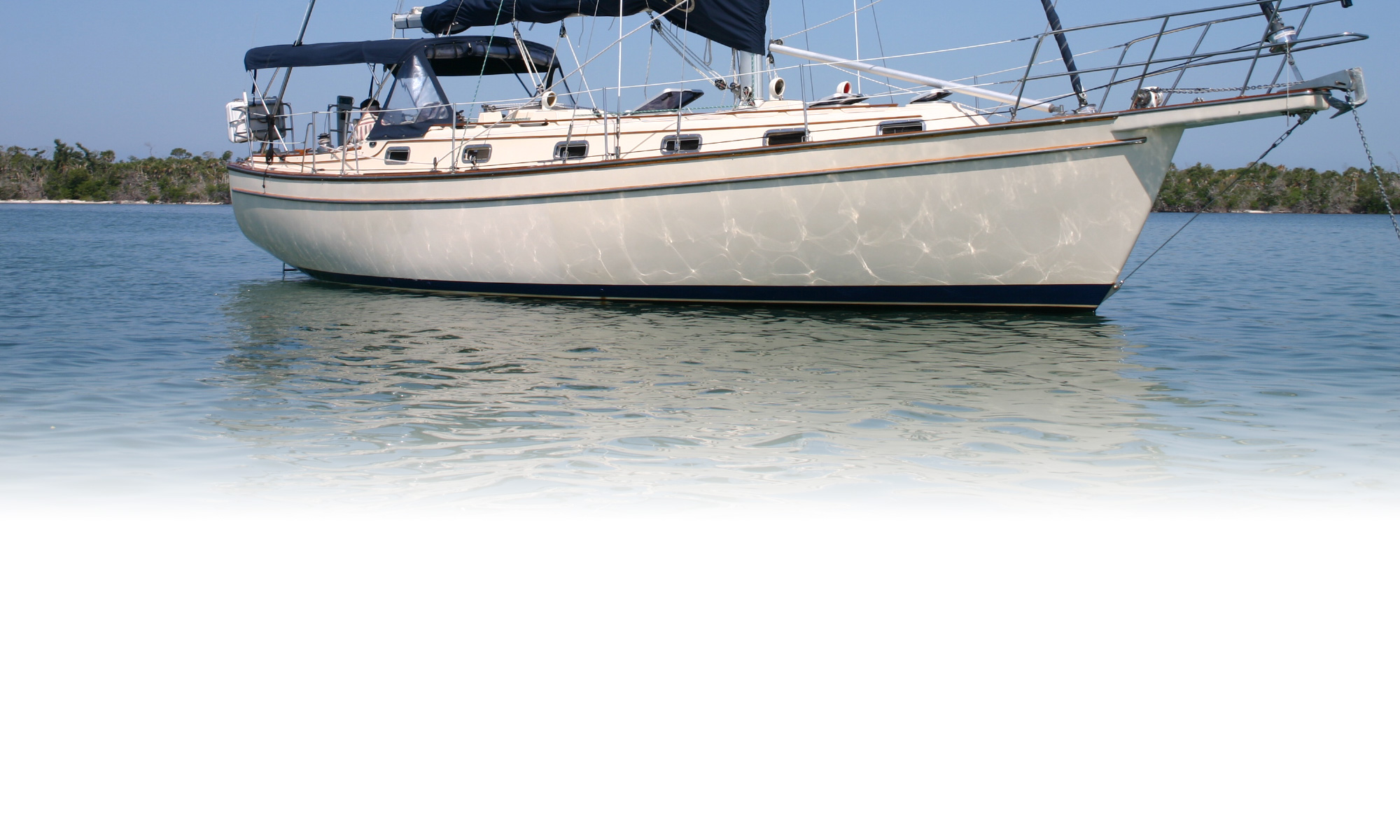
New Rudders
Replacement Sailboat Rudders and Centerboards
How Does A Sailboat Rudder Work
Sailboats steer by means of the rudder, a vertical, blade-like projection mounted either on the transom (the flat surface of the stern) or under the sailboat. In both cases the rudder works by deflecting water flow: when the helmsman—the person steering,—pivots the rudder, the water hits it with increased force on one side, decreased force on the other. The rudder moves in the direction of lower pressure. As the rudder goes, so goes the stern, and the boat turns.
During turns the boat pivots around a point near its center—roughly at the mast on a sloop. The stern moves one way, the bow moves the other way, as the boat changes direction. In very close quarters it’s important for the helmsman to remember this, and make allowances for the swinging stern to avoid colliding with other boats, docks, buoys, etc. Quite a few sailors make this mistake, but often not more than once.
Tiller vs Wheel
Most smaller sailboats (under 30 feet or so) use a “tiller” to turn the rudder. This is basically a stick made of wood or, sometimes, aluminum, attached to the top of the rudder. The tiller provides leverage to turn the rudder against the strong pressure of the water moving across it. This pressure can be substantial, therefore even on a small sailboat the tiller is up to three or four feet in length; in strong winds the helmsman may often wish it was even longer. Larger boats generally use a wheel, attached to the rudder by cables and a steel “quadrant” to provide sufficient leverage. While steering with a wheel takes less effort, a tiller is better for beginning sailors, since it provides instant response and feedback: if the sails are trimmed incorrectly, the skilled helmsman will feel it through the tiller. Because of this, some expert racing sailors prefer a tiller, even on large sailboats.
The continuous stress and pressure on the rudder underscores why sailors should practice regular rudder inspections and maintenance. If you need a rudder repair or a replacement rudder or centerboard for your sailboat, please contact us today.
- BOAT OF THE YEAR
- Newsletters
- Sailboat Reviews
- Boating Safety
- Sailing Totem
- Charter Resources
- Destinations
- Galley Recipes
- Living Aboard
- Sails and Rigging
- Maintenance
- Best Marine Electronics & Technology
Sailboat Rudder Inspection How-To Guide
- By Steve D' Antonio
- Updated: November 7, 2012
Rusty Rudder
Many conscientious cruisers aren’t sure when they should unship their sailboat rudder for inspection and what they should look for when they do. Like so many aspects of boat ownership, there are few hard and fast rules. Those based on the calendar or the number of miles traveled don’t take into account the design, construction materials, and climate or the preventive maintenance that’s already been carried out. Reliable steering, of course, is always a priority, but for vessels that venture offshore, the standard must necessarily be higher; rudder failure at sea can result in catastrophe.
A thorough inspection of the sailboat rudder while it’s in place can often yield clues to whether removal is the right approach. In many cases, the only portion of the rudder that can’t be easily inspected is the stock, where it passes through the trunk or log. Depending upon the design, removing the stuffing box from the trunk may enable the inspection of much of the stock, particularly where corrosion is most likely to occur, at the stuffing box’s packing. Here, wet packing remains in contact with the stock, which is nearly always a stainless-steel alloy. If the vessel remains dormant for long periods, as far too many do, the oxygen in the water contained within the trunk becomes depleted, which can lead to crevice corrosion of the stock, and this nearly always occurs directly beneath the packing or, if one is present, beneath a bearing.
| |The rudder’s stock-to-bearing interface should be inspected for excessive play or signs of rust, corrosion, or bearing debris.|
The area where the stock enters the blade is also worthy of close inspection. Mating such disparate materials as stainless steel and FRP or fiberglass produces a tenuous hold at best. In most cases, the bond between the two begins to separate early on in a rudder’s life; it’s a process that’s nearly unavoidable. Over time, water will often work its way down between these two components; if it’s a skeg-hung rudder, it may work up from the bottom. Once in this void, the oxygen in the water is depleted, once again becoming an ideal environment for crevice corrosion. And if the rudder’s armature, the metallic framework that supports the blade, is made from mild steel, as many are, then it, too, is susceptible to good old-fashioned oxidation or rust.
As disconcerting as this sounds, the good news is that telltale signs often indicate when trouble lurks beneath an otherwise seemingly unblemished FRP skin. Brown, rust-like stains are the product of crevice corrosion and rusting mild steel, and when you spot them on or beneath a sailboat rudder, they’re always cause for concern.
It’s possible to stem or retard entering water by caulking the interface between the stock and the FRP blade. Most polyurethane sealants won’t adhere to stainless steel for very long, so it may become a seasonal process; however, the effort is minimal, and the reward potentially great.
If the stock, blade, or supporting hardware, gudgeons, pintles, or hinges show any signs of deterioration, excessive wear, or corrosion (verdigris, the green patina taken on by copper alloys, is normal and no cause for concern), the rudder should then be unshipped for closer inspection and possible surgery. In the majority of cases, rudders can be repaired to sail another day. However, if obvious signs of distress are ignored, the resultant issues will often become terminal.
For fiberglass rudders, begin by inspecting the visible portion of the stock, between the blade and the hull. Are there signs of rust, corrosion, or pitting? If so, it’s time to remove the foil for a closer look.
Steve D’Antonio offers services for boat owners and buyers through Steve D’Antonio Marine Consulting .
- More: boat maintenance , DIY Sailboat Projects , How To , maintenance , monthly maintenance , rudder
- More How To
Is There a Doctor Aboard?
3 clutch sails for peak performance, it’s time to rethink your ditch kit, 8 ways to prevent seasickness, 10 best sailing movies of all time, kirsten neuschäfer receives cca blue water medal, 2024 regata del sol al sol registration closing soon, us sailing honors bob johnstone.
- Digital Edition
- Customer Service
- Privacy Policy
- Email Newsletters
- Cruising World
- Sailing World
- Salt Water Sportsman
- Sport Fishing
- Wakeboarding
RetireFearless
Rudder Types for Sailboats
A rudder is a one-of-a-kind technological achievement for sailboats. There are a handful of rudder types for sailboats to allow sailors to steer.

March 16, 2023
This article may contain affiliate links where we earn a commission from qualifying purchases.
Today’s sailboats use various rudders that serve unique purposes in steering or performance. You are probably wondering which rudder type you have on your boat and which one is best.
There are four types of rudders, which are skeg, spade, outboard, and full. Depending on the size of the boat and the hull will determine which rudder it will need. In addition, each rudder type will have a slight variation that will meet certain expectations of performance on the boat.
Sailors need to rely on a rudder in order to steer their boat efficiently. Each boat will not have the same rudder, as different styles of sailing require different rudders.
According to experienced sailors, each rudder has its pros and cons. However, the best rudder needs to match your expectations in sailing.

Table of Contents
Rudder Types
With the four rudder types mentioned, each one will have its pros and cons. As you begin your travels on bluewater or are interested in learning more, then it would not hurt to check out what each rudder is designed to do.
Full Keel Rudder
If you were to picture a sailboat with a rudder, it would likely be a full keel rudder. The most common rudder type is the full since a lot of sailboats use a full keel.
The reason a full keel is the most common keel on a sailboat is that it is the best one to provide stability. In that case, you need a rudder that can accommodate that type of boat.
On a full keel sailboat , the rudder looks like it is part of the keel itself. It is actually attached on a hinge, giving it the appearance that it is fully connected to the keel.
Advantages of a Full Keel Rudder
A full keel rudder is quite strong and actually helps tremendously with the protection of the boat. During a strong storm or harsh waves, it can be easier to navigate with this type of rudder. In addition, debris is significantly less likely to snag on anything like other rudders.
Disadvantages of a Full Keel Rudder
While a full keel rudder might be the best one to handle in strong storms, it is still the most difficult rudder to handle. Since the flow of the water is providing pressure on the full keel, it makes it harder to move the rudder. You would need to put a lot of effort into steering, especially in harsher conditions.
Skeg Rudders
Skeg rudders might give a full keel rudder a run for its money due to its durability. These are often referred to as skeg mounted rudders.
These are similar to full keel rudders, but can also be used on fin keel boats . This alone gives it a slight edge over full keel rudders, but each boat design will differ.
Advantages of a Skeg Rudder
With similarities to a full keel rudder, you are going to have the stability as well in a skeg rudder. The added bonus is that it works in either a full keel boat and a fin keel.
Disadvantages of a Skeg Rudder
Just like a full keel rudder, all of the pressure of the water hits on one side or the other. This means it will be hard to turn in rough conditions.
Spade Rudders
These rudder types are best fit for a fin keel boat rather than a full keel or to the types of boats. It enters straight down into the water and can rotate left or right using a post that extends within the hull.
Advantages of a Spade Rudder
The best advantage of a spade rudder is that it can be part of the fin keel. You can turn this rudder much easier than a full keel rudder or skeg rudder. The water is not forced one side or the other, allowing a better flow and easier turn.
Disadvantages of a Spade Rudder
If you sail upon a lot of debris in the water, you are likely going to damage the rudder. These are more delicate than skeg or full keel rudders, as they are more exposed.
Debris can get caught in between and potentially wrapped within the space rudder. In addition, rough water can be a nightmare. Tough conditions can cause enough pressure to bend or potentially break the rudder.
Outboard Rudder
Outboard rudders are not attached to the boat’s hull and are mounted outside at the back . Typically, these are not connected to a steering wheel and are connected by a tiller.
A tiller is a steering lever that can take some getting used to if you have solely used steering wheels. On smaller boats, sailors actually like a tiller over a wheel.
Advantages of an Outboard Rudder
If an outboard rudder becomes damaged, it will not typically affect the rest of the boat. This is because there is not a rudder post through the hull.
In the event that you damage it while at sea, you have the opportunity to fix it. Since it is on hinges and not attached to the hull, it might be able to be fixed. This also means the rudder might be stronger than other rudder types.
Disadvantages of an Outboard Rudder
Since the outboard rudder is at the back of the boat, it is vulnerable in some situations. If floating debris or something like a rope is in the water, it can tangle up in the rudder or damage it.
The location of the rudder also makes it harder to turn than a spade rudder. In tough conditions, this might be difficult to turn.
Purpose of a Rudder
A rudder is one of many important components of a boat to operate as efficiently as possible. Some boats are built for speed and others for comfort, so a rudder also has to fit that category.
Water pressure will dictate how the rudder moves in the water. Whichever direction you turn the rudder, then water pressure will push against it and allow you to turn.
While a sailboat is turning, it is pivoting around a middle point of the boat. The stern and bow move at the same time, while the middle point of the boat remains in place. Knowing how to properly operate a rudder to steer can make a huge difference in avoiding a crash.
Variations of Rudders
While some rudders are fairly cut and dry for their intended use, other rudders have slight variations to the design. This allows a little bit of flexibility on some boats, which is great because not all boats are designed the same.
Balanced Rudder
A balanced rudder is a form of a spade rudder with a slight difference in free space at the top. The leading edge allows rotation from one side of the boat while the trailing edge goes opposite.
The post is also a few inches back from the front of the rudder, which is slightly different from a regular spade rudder. Even though the turning action is roughly the same in comparison to a spade rudder, the force on the helm has more balance and makes it easier to steer.
You will usually see this type of rudder in performance boats or yachts. Furthermore, they are always paired with a fin keel to provide the best performance overall.
The only drawbacks to a balanced rudder is that it is susceptible to debris if you were to run anything over in the water. You have to rely on the structural integrity and hope that it is strong enough to take a blow. If it were to fail, it does not revert back to the center and might make it difficult to navigate the boat.
Unbalanced Rudders
Unbalanced rudders have the support from a full length skeg and are attached to the furthermost point of their span. It is unbalanced because the entire rudder is aft of its axis or the centerline where the rudder stock is located.
When you begin turning this rudder type, you get all of the force on one side. Whoever is steering the boat will notice this feeling compared to other rudder types, especially when using a tiller.
As you can gather, these rudder types are not commonly used today. You might find one used in history books or replicas of older boats.
If this were commonly in use today and were to fail at sea, the rudder remains in place and not go back to the centerline. This caused serious issues in the past and arguably why it is not very popular anymore.
Semi-balanced Rudders
If you can picture what a balanced and unbalanced rudder would look like, then a semi-balanced rudder is something in between. The name suggests that it is partially balanced and unbalanced at times.
The top part of the rudder is unbalanced, while the lower part is balanced. With the top part being this way, it helps by providing structural support to the rudder by aiding in vertical displacement.
During this process, the balanced section will endure less torque pressure during swings. It will then return back to the centerline if the steering equipment fails, which is a critical aspect that balanced and unbalanced rudders did not originally have.
Semi-balanced rudders are also different from other types since they vary in size and shape. You will often hear sailors talk about the depth of the horn, which is the connection between the rudder and the boat.
A shallow horn rudder has a horn that extends less than half of the chord length from its top. In a deep horn rudder, the horn extends more than 50 percent of its chord length from the top.
Semi-balanced rudders have had some unique innovations over the years. They appear to be the best of both worlds between balanced and unbalanced.
Twin Rudders
Twin rudders have been used since 1980 among racing boats. Over the last decade or so, they have increased in popularity among cruising sailboats.
Twin rudders have a history of being difficult to operate in tight spaces if you do not have experience with them. This is true, especially since it navigates a little differently than one rudder.
When using a boat that has a twin rudder, the prop wash moves by both rudders and you cannot have the same maneuverability as with one rudder. One tactic you could do is to increase your boat speed to increase water flowing between the rudders. In doing so, it could cause some concern in tight spaces if you are unable to land exactly where you want.
One positive to twin rudders is that it performs well in reverse. You do not have as much prop walk as other boats and can handle better in lower speeds due to increased blade length on both rudders.
Another benefit is that it responds better to the wind. In single rudder boats, the wind can push the bow in one direction while the stern goes opposite. For twin rudders, the wind does not have as much of an impact in that regard.
Can Rudders Fail While in Use?
Just like anything in life that you use, it has a lifespan on it. For a rudder, some can fail while you are using them at sea.
Rudders failing at sea is actually a common hazard, so knowing what to do in that situation is very important. Sometimes cheaper boats, like a fiberglass boat, will experience a rudder failure likely before a more expensive boat.
The material of the rudder pole has to be a good blend of flexibility and strength. If it is too weak, it will break. If it is too strong, it might damage the hull since it cannot flex properly.
The framework inside the rudder should be a heavy-duty metal, because if it breaks, then it will be unusable. This is likely the case in cheaper boats, where costs have been cut in certain areas. Depending on the boat brand, you might see welding jobs that are not executed properly for rudders.
In addition, the type of rudder you use at sea can make a big difference. Full keel rudders might be the best option since it is protected from debris and offers the best stability. Depending on your sailing goals, the right rudder type will be different for everyone.
What are Rudders and Stocks Made out of?
Rudders have historically been crafted out of heavy duty stainless steel or aluminum. You want something that is non-corrosive and can withstand some beating.
If you were to look at high performance yachts, these typically have alloy since it is lighter but also strong. Stainless steel can handle swelling and debris, but crevice corrosion could be an issue.
Composite is another material that is used in mass production yachts or high performance boats. Some material is arguably better than others, but there is really not a perfect option out there. A proper inspection is needed before doing any long term use at sea.
Why a Tiller Could be Better than a Wheel for Rudders
If you have sailed a boat with a steering wheel and have never used a tiller, you could be missing out. Regardless if you are new to sailing or a seasoned pro, a tiller is very easy to use.
Tillers provide instant feedback when turning a boat, whereas steering wheels take a minute to get results. For newer sailors, a wheel could prove to be frustrating in rough conditions.
Depending on the size of your boat, a wheel might be the better option. In larger boats, a tiller does not perform the same.
Even though a tiller is harder to turn, it still offers an immediate reaction. This is why you will oftentimes see tillers on racing boats because they provide instant feedback.
What Happens if Your Rudder Fails?
While safety is a priority in everything you do while sailing, there are some situations you cannot avoid. No matter how much preventative maintenance you do, your rudder might still become damaged or unable to use.
If bearings have seized, the rudder can become difficult to move at first but will eventually lock up. Your steering capability will eventually be impossible and quite difficult to stop the boat from rounding into the wind.
If it were to fall off completely, then you will have quite a difficult time tracking the boat. The rotation of the boat might even be abrupt or rapid.
It is important to stay calm during a situation like this and to check on the crew. Drop your sails and attempt to gain some control.
You could even try pointing the bow into the wind and dropping anchor to reduce motion. Once the boat is under control, check for damage and call for assistance.
If you cannot phone for assistance, the best thing you can do is to create a makeshift rudder or potentially purchase one before a situation like this happens. For example, brands like Seabrake and Delta Drogue are quality rudders you could use in a pinch to safely make it back to shore.
Recent Articles

What Size Sailboat Can One Person Handle?

How To Tie A Sailboat To A Mooring Ball Ring

What Is The Ideal Wind Speed When Sailing?

How To Use a Sailboat Winch

Things You Need To Liveaboard a Sailboat

Types of Sailboat Keels
I'm Michael Moris. I've been sailing my whole life, and it has taken me to places I never imagined. From the Caribbean to Europe, from New Zealand to South America - there's nowhere that hasn't felt like home when you're on a boat!

Trending Articles

How Far Is Havana From Miami By Boat?

Yachting Vs Sailing

Who Is Sailing Doodles?
Subscribe To Our Newsletter
Thank you! You're signed up for our free newsletter!
Oops! Something went wrong while submitting the form
About Our Team
We are a publishing team of licensed Nursing Home Administrators, Nurses, Assisted Living Directors, Health Professionals, Gardeners, and individuals with vast experience with senior living and activities.

©2024 Retire Fearless. All rights reserved.
We can be reached via email at [email protected]
Retirefearless.com is a participant in the Amazon Services LLC Associates Program, an affiliate advertising program designed to provide a means for sites to earn advertising fees by advertising and linking to Amazon. This site also participates in other affiliate programs such as CJ, ClickBank and more, and is compensated for referring traffic and business to these companies.
Facebook Pinterest
How to Build a Sailboat Rudder From Scratch

Introduction: How to Build a Sailboat Rudder From Scratch

This particular rudder is built off of the original rudder for a ~20' Bayliner Buccaneer sailboat. The original had cracked and rotted pretty badly. The owner of the sailboat cut the top of the rudder off and made a wooden 'boot' to cap the rudder. However, it wasn't water sealed with fiberglass, and over time more and more moisture got in until it became so flimsy that it wasn't reliable. While this instructable is specifically for this Bayliner sailboat with a tiller-style rudder, the instructions should be general enough for you to modify it to work for many sailboats. With that said, there are many many nuances to fiberglass/composite marine construction, so this type of build will require more research beyond what is covered here.
Step 1: Previous Rudder

In these photos you can see the extent of the damage. The rudder was foam-core/fiberglass sandwich. Think of it as a Big Mac; the three buns of the Big Mac were layers of fiberglass, and the meat was the foam (the yellow stuff). The only difference was that the buns would have all been connected and fully enclose the meat. First, I cut apart the rudder along its perimeter with an oscillating saw, so that I could use the pieces as templates for the build. In the fifth image you are seeing a piece of balsa (I think) at the edge of the rudder where the mounting hardware was located so as to provide compressive stability for the tightened hardware. In the last image, if you look at the top of the image you can see where the previous owner had chopped off the top of the rudder. There was a rudimentary wooden cap on that, so you can see how easy it would have been for water to get in.
Step 2: Rebuild

Because of the difficulty of rebuilding the rudder the same way, I chose to use two sheets of 3/4" solid plywood. While this increased the overall weight of the rudder, it ensured maximum strength and stability. There is a good reason that I chose to do it in two pieces: I wanted to be able to sand the exterior faces of the rudder in order to get a tapered surface, and by doing it in two pieces allowed me to have the piece be level on one side. In the first image below, you can see the old pieces of the rudder all stripped of foam next to the new plywood pieces. In the background you can see the middle fiberglass 'bun' of the whole kit 'n caboodle. I scraped away all of the foam because I had originally wanted to save the exterior pieces and reuse them, but the Big Mac style construction made it more difficult to reuse them. Simply place the old pieces on your sheet of plywood, trace, then cut out with a jigsaw. If for some reason, you only have one template to work with, and you are using two pieces of ply that will later get glued together, be sure to flip the template over before tracing, so you have mirrored pieces. The customer asked for a little more material at the top of the rudder, as you will see in the last images of the Instructable. It ended up making it look a little strange, however.
Step 3: Sanding

Unfortunately, I only took one image of the sanding process, shown below. As I mentioned, it is good to sand the two pieces separately, although this picture is of the two already glued together. A handy trick is to imagine your surface and the lines of ply as the lines on a topography map. The curved edge of the rudder closest to us in the image is the narrowest edge, from the little notch all the way down the side to the very bottom of the rudder. This is because it is the edge of the rudder that points forward when it is on the boat. I started by using a disc sander, but it was too slow, so I switched to a grinder. The grinder worked well, but it was a bit too fast, so if you decide to use one, be very judicious in your use of it, otherwise you will end up with big divots.
Step 4: Fiberglass Layup

As I already alluded, there are many many variations to fiberglass construction. For this project I used chopped strand mat (which you can see in the first image), and a woven fiberglass cloth on top of that, with vinylester resin. Later on in the project I switched to West Systems Epoxy 105 and 205, because it was on hand. This type of layup requires you to use both the mat and the cloth in one process. The general idea is that you cut your mat to about the same size as your rudder, pour your resin on top, spread it and around, then immediately lay on the cloth (that you have also already cut to size), and the resin underneath should be enough to saturate the cloth. Often, however, it wasn't, and I had to mix more up really quick and pour it on top of the cloth to get it fully saturated. This is where you will need to conduct more research on mixing ratios of resin, temperature, amount per surface area, etc. Generally, I was able to get about 30 minutes of working time out of each batch. In the back is a finned roller that you use after you mix and start pouring the resin to remove the air bubbles from under the chopped strand mat and to spread the resin around. After a while the roller gets all gummed up, and I ended up using just my gloved hand to push out the bubbles, and I found that a simple plastic spreader worked best for spreading. Don't worry about the stuff that hangs over the sides. Originally I wanted to have it fold over and seal the edges at the same time, but this was near impossible, as we will see soon, and I just let it hang and harden from any of the spilled over resin. I dealt with it later with a lot of sanding.
Step 5: First Layer and Sanding

The order I used was as follows: Glass one side of the rudder, let cure. Cut off excess edge stuff and rough sand/grind. Glass other side of rudder, let cure. Cut off excess, sand until flush. Glass edges based upon which were generally 'up' when clamped in a mostly horizontal way (images 4 and 5). Glass the remaining edges. Sand the nasty edges until flush. The first image is after the glass on the faces have cured, showing the excess. The third image was after sanding the excess from the faces. The following images were taken doing first layers of the edges, after the faces.
Step 6: Additional Layers and Difficult Spots

I don't remember exactly how many layers went on total, because after sanding where necessary, sometimes more wood gets exposed, and all that's required is a simple patch. The first image is after fully sanded face and edge layers. There are some really difficult spots that you need to pay attention to. Generally, corners are the spots you need to look out for. It's like trying to wrap a piece of paper over a 3D form without letting any edges lift. They will tend to lift up one end of your saturated cloth and allow air to get right in there, which means you'll have to sand that air bubble out and re-do it later. The very bottom tip of the rudder was one of them. Although the second picture is after I had drilled the holes for the hardware, it's useful to see the method for tackling those difficult spots. Visibile at the tip of the rudder is a bit of blue painter's tape. For that spot and others, which I will mention later, I basically taped the heck out of it, making a small well, and poured in enough resin to cover it. You can also see in this picture, how it has started to get thick/bulky. That's normal as layers build, you just need to sand it down flush later. Sometimes the tape gets sealed in there, so I just left it in.
Step 7: Notes of Caution

If, after a good amount of sanding, your rudder has patches of white at the surface and you can feel a clothy texture when you run your fingers over them, it means the cloth did not get fully saturated and means the surface is not fully sealed. When this happens, it is sufficient to mix up a new batch of epoxy/resin, and spread it over the surface(s) without the need for another layer of cloth. The entire surface is sealed when all of it feels smooth/looks glossy and hard, although some spots may still be bumpy. After you think you've sealed the whole rudder and you go to sand it smooth, you may uncover more white patches or air bubbles. It's extremely frustrating to think you're almost done and find another one of those, but it pays off to patch them properly. If there are some air bubbles or pockets that just don't seem to patch up and keeps reappearing after you sand this product is really helpful: http://www.marinetex.com/marinetexepoxyputty.html. It's a putty-like marine epoxy, so it serves the same purpose as regular epoxy, but it is much more workable and can be packed into a hole to completely seal it. The is the best product for repairs of deep scratches or small punctures in a fiberglass surface. The notch at the top of the first image was one spot that I taped significantly in order seal every spot with epoxy. This is the point where I switched to epoxy from resin, as I had run out. The purple is the natural color of the epoxy after it hardens.
Step 8: Hardware Holes

This step is extremely important and tricky. If, by chance, you have the previous hardware which mounts the rudder to the transom of the boat, great. Use them as guides as you don't want to make your rudder thicker than the original and not fit into the hardware. If you don't have previous hardware and your boat needs a very specific bracket, go buy it early so you can make sure to construct your rudder to fit into those, otherwise, just buy some to suit. Use this tutorial to help you get the holes right: http://www.boat-project.com/tutorials/drill.htm. Basically, you need to drill your holes bigger (1.5x, I think. The tutorial with specify this.) than the hardware needs. You then fill the hole with epoxy and let cure. Then you drill your holes again with a bit sized for your hardware. After painting, get some sealant (specified in the tutorial) and coat the bolts, holes and the inside face of the bracket immediately before placing them on the rudder. It's really important to drill your holes square through the rudder. If you don't, you'll find when putting the bolts through, that they won't meet with the bracket holes. If you're slightly off (like I was), you can just enlarge the hole at the problem end. If you're really off, you'll have to sand the paint away, drill the new hole, fill with epoxy again, re drill, then paint.
Step 9: Painting

Painting a boat or any underwater surface is another realm that has a large amount of nuance, specificity, and also varying opinions. It is still a bit unclear to me, but the most ideal situation is to find a marine paint that actually bonds with your fiberglass/epoxy surface. Interlux makes really good products and they have tutorials on which paints to buy and how to apply them: http://www.yachtpaint.com/usa/diy/default.aspx. Before painting, you must 'cut' the surface (a light sanding), so there is surface for the paint to bond to, and you will need to remove any oils or chemicals that are on the surface with acetone or a similar product. The paint will usually specify a total thickness of paint required to be considered sealed, and will allow you to calculate the number of coats from the average thickness per coat. Next use a top-side paint (I think we used an auto-body paint) to cover the surfaces above the waterline to make it look nice. Lastly, apply a bottom paint (also called anti-fouling paint) below the waterline of the rudder. Bottom paints, especially, vary greatly by geographical location, type of water, EPA legal restrictions, etc. Their purpose is to prevent organisms from attaching to the submerged surfaces, so naturally, they will contain certain chemicals and/or metals. Copper is a common ingredient in anti-fouling paint, as it slowly leeches from the paint, preventing any organisms from attaching permanently.
Step 10: The End!

Attach the hardware and tiller, and you're ready to put it on the boat!!! (That's my pops holding the rudder.)
Recommendations

Made with AI - Autodesk Design & Make - Student Contest

Make it Resilient

Fix It Contest
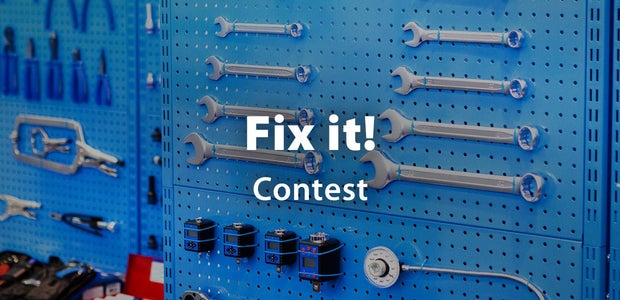

Rudder Types For Sailboats
As a sailor, you know that the type of rudder on your boat can have a big impact on its performance.
There are several different types of rudders available for sailboats, each with its own advantages and disadvantages.
In this article, we’ll take a look at some of the most popular rudder types and see how they can affect your boat’s handling.
4 Types Of Rudders On Sailboats
Rudders are an essential part of any sailboat, providing both steering and stability. There are a variety of rudder types available, each with its own advantages and disadvantages. In this article, we’ll take a look at four of the most popular types of rudders used on sailboats.
The first type of rudder is the keel-steered rudder. This rudder is attached to the keel of the boat, making it very stable. However, it can be difficult to turn, and is not recommended for boats that need to make tight turns.
The second type of rudder is the centerboard rudder. This rudder is attached to the centerboard, or daggerboard, of the boat. It is easier to turn than a keel-steered rudder, but is not as stable.
The third type of rudder is the stern-mounted rudder. This rudder is mounted on the stern, or back, of the boat. It is the easiest to turn of all the rudder types, but is also the least stable.
The fourth and final type of rudder is the rudderless sailboat. As the name suggests, this type of boat does not have a rudder. While this may seem like a disadvantage, it actually provides a number of advantages.
First, it is much easier to turn. Second, it is more stable than a boat with a rudder. Finally, it is more resistant to capsizing.
So, there you have it! Four of the most popular types of rudders used on sailboats. Each has its own advantages and disadvantages, so it’s important to choose the right rudder for your boat and your sailing needs.
Full Rudder
A full rudder is the most common type of rudder found on sailboats. It is attached to the back of the boat and extends into the water. The rudder is connected to the steering wheel and is used to steer the boat.
Full rudders are very stable and provide good control in all types of weather. They are easy to use and require little maintenance.
Spade Rudder
A spade rudder is a type of rudder that is mounted on the back of the boat, near the waterline. It is attached to the boat with a metal or wooden frame. The rudder is usually made of metal, but can also be made of wood or fiberglass.
A spade rudder is typically used on smaller sailboats, because it is easier to maneuver than a keel-mounted rudder.
It is also less likely to get caught in weeds or other debris in the water. However, because the rudder is mounted near the waterline, it is more susceptible to damage from waves or collisions.
Skeg Rudder
Skeg rudders are the most common type of rudder used on sailboats. They are simple in design and easy to operate.
Skeg rudders are attached to the back of the boat with a metal or wooden skeg. This skeg provides support and helps to prevent the rudder from damage.
Skeg rudders are typically used on smaller sailboats. They are not as effective on larger boats because they can be difficult to turn. Skeg rudders are also more susceptible to damage than other types of rudders.
Outboard Rudder
Outboard rudders are the most common type of rudder found on sailboats. They are attached to the back of the boat and extend into the water. Outboard rudders are very effective and provide good control of the boat.
How Does A Rudder Work?
A rudder is a fin attached to the back of a boat that helps to steer it. The rudder is connected to the steering wheel or tiller and is moved left or right to turn the boat.
When the rudder is turned, the water flowing past it creates a force that turns the boat in the opposite direction.
The amount of force created by the rudder depends on the size and shape of the rudder, the speed of the boat, and the angle at which the rudder is turned.
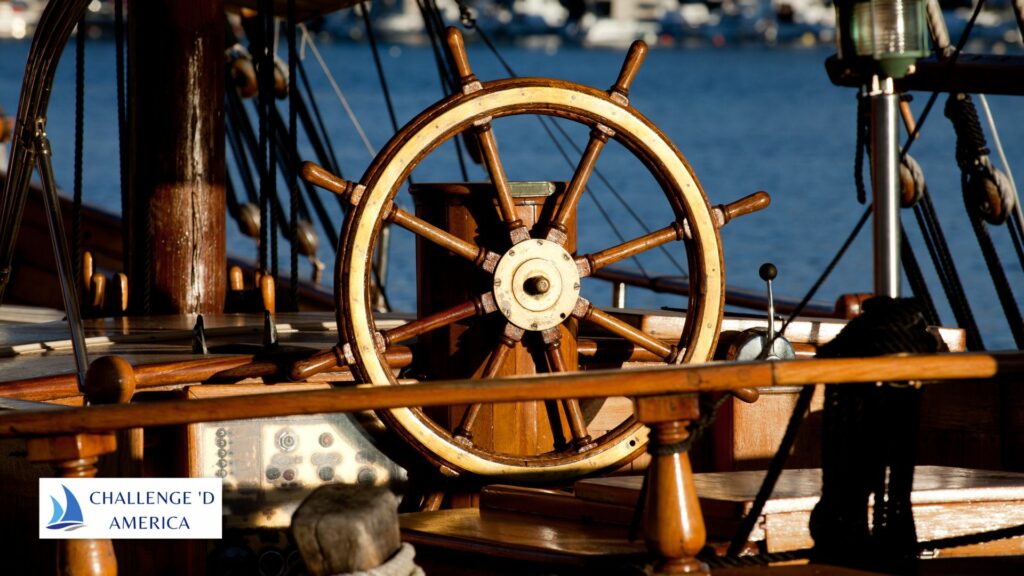
The rudder is most effective when the boat is moving through the water. That’s because the water flowing past the rudder creates a force that turns the boat. The faster the boat is moving, the greater the force created by the rudder.
Rudder size and shape also affect how well it steers the boat. A rudder that is too small or has the wrong shape will not create enough force to turn the boat.
A rudder that is too big or has the wrong shape will create too much force and will make the boat hard to control.
The angle at which the rudder is turned also affects how well it steers the boat. When the rudder is turned too far, it can create too much force and make the boat hard to control.
Rudders are most effective when they are used in conjunction with the sails. The sails provide the forward motion that the rudder uses to create the steering force.
Rudders are an important part of a boat’s design and play a vital role in steering. With the right size, shape, and angle, a rudder can help a boat sail smoothly and safely through the water.
What Is The Purpose Of The Keel?
The keel provides lateral resistance to wind and wave action, keeping the boat pointing into the wind and on course.
It also provides buoyancy, countering the weight of the hull and crew and keeping the boat afloat. In addition, the keel helps to stabilize the boat, preventing it from tipping over in strong winds.
Do Rudders Often Fail At Sea?
No, rudders don’t often fail at sea. In fact, rudder failure is quite rare. That’s because rudder systems are designed to be very strong and durable.
They are typically made from tough materials like stainless steel or aluminum. And they are built to withstand the constant pounding of waves and the occasional collision with a submerged object.
So while rudder failure is not common, it can happen. And when it does, it can be a serious problem. If a rudder fails, the boat will lose steering and may even start to drift.
That’s why it’s important to have a backup plan in place in case of rudder failure. For example, you might carry a spare rudder or have a way to jury-rig the steering system.
Of course, the best way to avoid rudder failure is to keep your boat well-maintained. That means regularly inspecting the rudder and its mounting hardware.
If you notice any cracks or damage, have it repaired or replaced as soon as possible. By staying on top of maintenance, you can help ensure that your rudder will be there when you need it.
Is A Longer Rudder Better?
No definitive answer exists to this question. Some sailors prefer a longer rudder for better steering control while others find that a shorter rudder is easier to manage.
Ultimately, it is a matter of personal preference and what works best for your particular sailing style.
Which Rudder Is Best?
There are many factors to consider when choosing the best rudder for your sailboat. The most important factor is the type of sailing you will be doing.
If you are primarily racing, then a racing rudder will be your best option. If you are mostly cruising, then a cruising rudder would be a better choice.
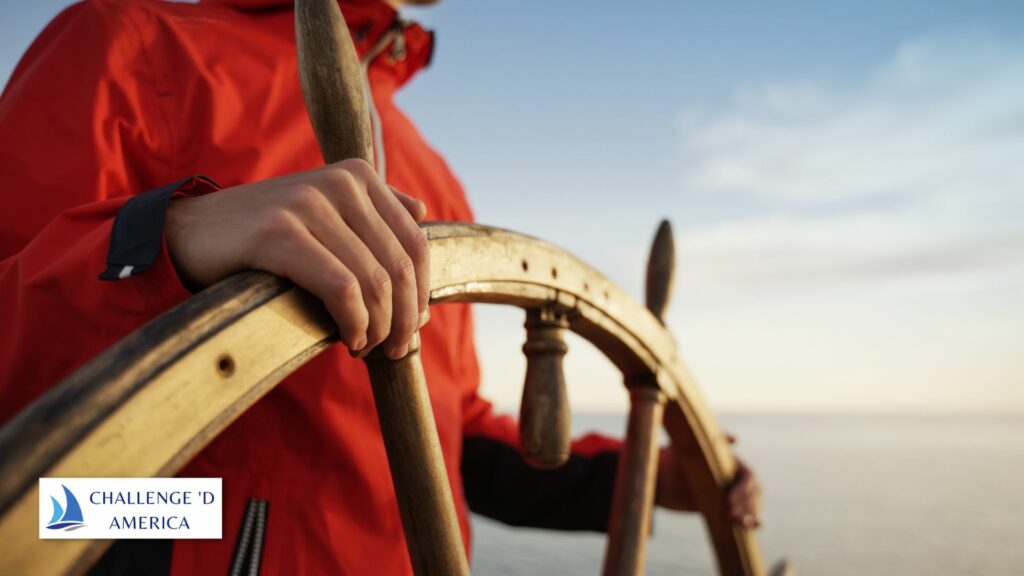
There are also different types of rudders available, such as keel-stepped, winged, and transom-mounted. Again, the type of sailing you will be doing will dictate which type of rudder is best for you.
Finally, you also need to consider the size of your boat when choosing a rudder. A bigger boat will need a bigger rudder, and vice versa.
So, which rudder is best? The answer is, it depends on your specific needs. Talk to your local sailboat dealer or rigger to get the best advice for your situation.
What Is The Function Of Rudder?
The function of rudder is to provide directional stability and control for a sailboat. It is attached to the stern of the boat and is used to steer the boat by deflecting the water flow. The rudder is also used to keep the boat on course by countering the force of the wind.
What Is Semibalanced Rudder?
A semibalanced rudder is a type of rudder that is partially balanced. This means that the rudder is not completely balanced, but is balanced enough so that it does not need to be constantly adjusted.
This type of rudder is often used on sailboats because it provides good control and is easy to use.
Conclusion On Rudder Types For Sailboats
There are many different types of rudders available for sailboats, and each has its own advantages and disadvantages.
The type of rudder you choose should be based on your specific needs and the conditions you typically sail in. If you’re not sure which type of rudder is right for you, talk to a qualified sailing instructor or dealer.
Similar Posts

How Can You Choose The Best Anchor For Your Sailboat Based On The Type Of Bottom And Conditions?
Ahoy mates! As an experienced sailor of many years, I know a thing or two about the importance of having the right anchor for your sailboat. It may seem like a small detail, but a good anchor is essential for ensuring a safe and secure journey. Today, I’m going to be sharing my expert advice…

Average Sailboat Speed
How fast can you expect your sailboat to go? It depends on a number of factors, but average sailboat speed is somewhere between 5 and 10 knots. Of course, this is just an average – some boats will be faster, and some will be slower. But if you’re wondering how fast your boat can go,…

What Is The Stern Of A Ship?
The stern of a ship is the back end. It’s where the rudder is located, and it’s the direction the ship is facing when it’s moving forward. The word “stern” comes from Old English and originally meant “the steering oar of a boat.” Today, the stern is still an important part of a ship. It’s…
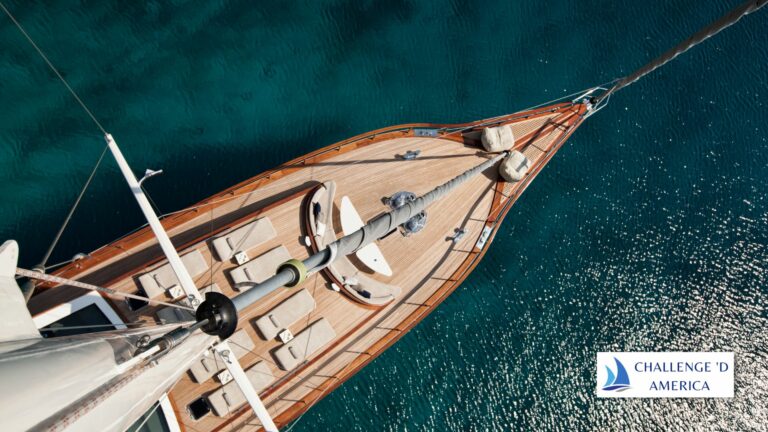
What Size Sailboat To Live On
If you’ve ever dreamed of living on a sailboat, you’re not alone. Making the decision about what size sailboat to live on can be daunting. That’s why I’m here to help. In this article, I will discuss the various factors to consider when deciding on what size sailboat to live on. From layout, to size…
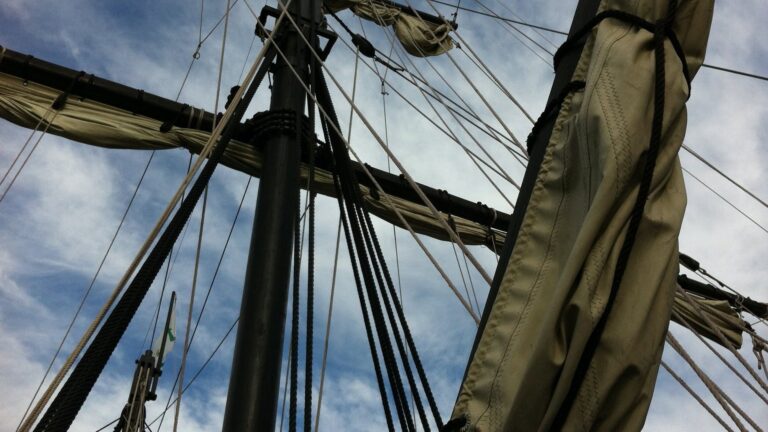
What Is The Only Rope On a Sailboat?
The One and Only Rope on a Sailboat: The Bolt Rope When it comes to sailing, most people think of rope, sails, and masts as essential components of any boat. But when it comes to sailboats, there is only one “rope” which is essential: the bolt rope. As the name implies, this is the main…
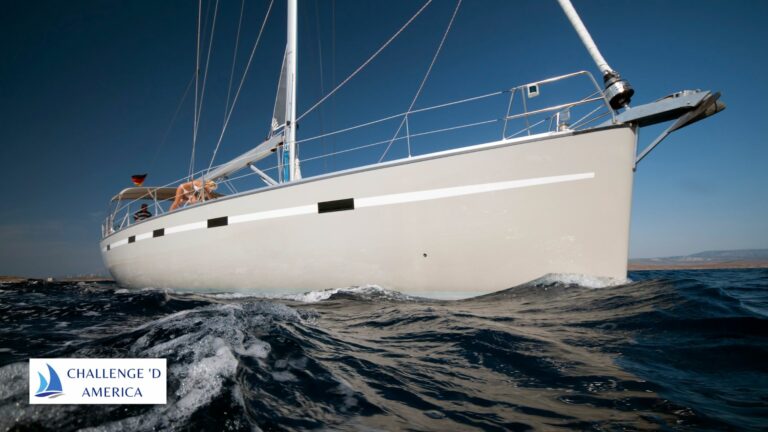
What Is Hard Dodger? How To Build A Hard Dodger For Sailboat
Hello sailors! Today we will be talking to you about a great sailing innovation that you may not have heard of: the hard dodger. This is an accessory that can be added to your sailboat to provide enhanced protection from the elements, such as wind, rain, and sun. In this article, I’ll explain what a…
Leave a Reply Cancel reply
Your email address will not be published. Required fields are marked *
Save my name, email, and website in this browser for the next time I comment.

Do Sailboats Have Rudders? (All You Need to Know)
Categories Sailing
Those who love adventures in water and sailing know about sailboats. Sailboats are vessels that run on wind power. And its controlling mechanism falls upon the rudder of the boat.
Do sailboats have rudders?
Sailboats do have rudders. The use of wind power to sail is the main feature of a sailboat. And the steering equipment that helps in making turns is the rudder. It is an underwater blade that works using a lever. This blade functions by creating unequal pressure of water.
Table of Contents
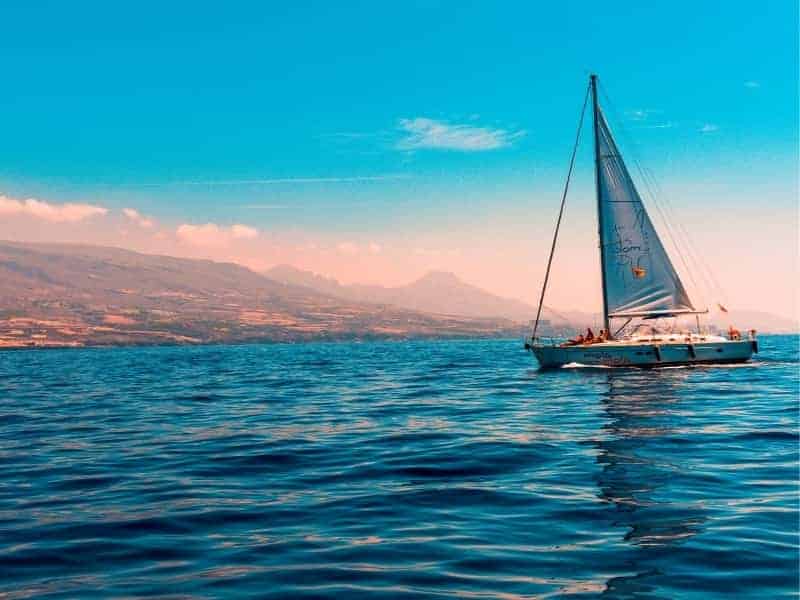
What is a rudder on a sailboat?
The rudder on a sailboat helps in its steering. It determines the direction of turns of your boat.
The rudder attaches to the rear end of your boat. It is basically a blade that remains under the water. This blade has to be controlled by a lever on the boat.
The lever which controls the rudder of a boat is known as the helm or tiller. The size of the rudder depends upon the size of your boat.
In small boats, you have to operate the helm manually. In big boats, the controlling lever is heavy and not controlled manually.
The rudder deflects the flow of water under the boat. When you move it in any direction, low and high pressure produces on both sides of it.
The direction in which the movement of the rudder creates low pressure moves in that direction. And this is how your sailboat takes a turn.
A sailboat is the kind of boat that sails with the aid of wind power. The sail in a sailboat is the structure that propels your boat. Other than the sail, you will need a rudder to operate your sailboat.
Rudders are the structure that controls the flow of direction of a ship or a boat. A sailboat has a rudder. It facilitates your boat to sail properly. Even if you want to navigate straight, it will help to keep your boat straight.
The purpose of a rudder in a ship is in its steering. There are various kinds of rudders. You have to choose your rudder according to the need of your vessel.
Moreover, the movement of the rudder moves the head of the boat in the same direction. The unequal pressure of water and its effects are in use to make turns. The lower pressure is the direction in which the rudder moves.
Types of rudders on sailboats
Rudders come in different shapes and sizes. For use in sailboats, there are mainly four types of rudders. These four types then also come in various variations. The four types of rudders for sailboats are:
Full rudders or full keel rudders:
This design provides more stability and firmness to your boat rather than speed. They are durable and resistant to various harms.
This rudder structure seems like a part of the keel. It runs all along the hull of your boat and keeps it straight and moving with ease.
It is useful both on and offshore. It maintains stability in rough water and does not even damage during grounding.
These rudders are not much in use nowadays. Other fin structured keel rudders have become famous now. But these rudders are one of their kind for their sturdiness and function.
Outboard rudder:
These rudders attach to the stern of your boat and hang off it. It is commonly in use for smaller boats or vessels.
They do not run all along the hull of your boat. These rudders work through a manual tiller or helm.
Outboard rudders are super easy to make. They come in handy in emergencies as well. Anyone can use a piece of wood to make this rudder. They are easy to make and operate as well.
Spade rudder:
Spare rudders are modern rudders that are in use for fin keelboats. They are versatile and require less force to move in any direction.
This rudder is comparatively faster. It distributes all of its force on both sides of the rudder. That is, it does not distribute force on one side only.
Rough water and weather can affect spade rudders. Also, dirt and debris can accumulate in this rudder. Although these rudders are fast, this dirt and debris can reduce their speed as well.
But these rudders are popular nowadays. They are widely in use in modern boats. Only this rudder can meet the limitation of rudders exerting pressure on one side of the water.
Skeg rudder:
Skeg rudders are better in terms of protection and performance. These rudders make your boat fast and save it from danger.
These rudders are in wide use for the modern fin keelboats. And you have to exert more energy for turning a skeg rudder. Only one side of the boat will experience more pressure when this rudder is in use.
Skeg rudders are popular. Most fin keelboats can use skeg rudders now. Unlike full keel rudders, these rudders provide more speed and a steering mechanism.
Can you sail without a rudder?
A rudder is a crucial steering part of a boat. There have been records of instances of losing the rudder on the sea.
There are ways to sail a sailboat without a rudder. So, a sailboat can sail without a rudder. For this purpose, you will need the help of the sail trim and daggerboard.
A sailboat functions on the mechanism of the sail and wind power. Proper use of the sail and other parts can save your boat. You can sail without a rudder with the help of your mainsail, jib, and daggerboard.
A little practice on the techniques of controlling your boat and wind can help you go a long way.
How to build a sailboat rudder?
Building a sailboat rudder will require some patience and expertise. Some steps on how to build a sailboat rudder are given below:
- Step 1: Select the material for your rudder and use a stencil or old rudder to cut the frame or template for the new rudder.
- Step 2: Sand the exterior faces of the rudder frame and make it a little tapered.
- Step 3: According to your chosen fiberglass, cut the covering mat according to the size of the rudder and lay it up on the rudder using resin.
- Step 4: Then sand the rudder to patch the rough spots as necessary.
- Step 5: If there are any hardware holes, fix and cure them using epoxy. Do this for every hole, and do not leave out anything.
- Step 6: Paint your rudder according to the color of your boat.
- Step 7: Attach the rudder to the hardware of your boat.
What is an emergency rudder?
The emergency rudder is the rudder you use to sail your boat when you lose your rudder. It is also in use if your rudder stops functioning.
The emergency rudder is of two types. They are the get home/SOS rudder, and the other one is the racing rudder.
The SOS or get-home rudder helps you to sail to the nearest shore. This rudder comes as an extension with many boats. Or you can also DIY a rudder using a board or similar thing to make a temporary one.
The racing rudder lets you sail up to your aiming destination. These rudders help you to sail hard.
What do you do if you lose your rudder?
If you somehow lose the rudder of your boat in the water, you can use an emergency rudder to get to the nearest shore.
Losing the rudder can make your boat unstable. Try to control the sail of your boat and use the daggerboard to control the use of wind power.
You can sail your boat using the mainsail and jib. If not, you can also make an emergency rudder using a hardboard piece of wood.
But knowing how to steer your boat without a rudder and steering it with the sails can help you go a long way. Sailors use this method of sailing to cope up with emergencies.
How do you steer a sailboat without a rudder?
Every sailboat runs on wind power. The flow of wind helps in the sail of your boat. The mainsail of your boat and the rudder together control the flow and direction of it.
If you somehow lose your rudder, you have to take proper measures to sail your boat according to your need.
To sail rudderless, you have to adjust the positioning of the daggerboard and sail trim.
When you pull in the mainsail of a sailboat, it turns in the direction of the flow of the wind. Similarly, pushing your daggerboard will also go with the wind.
So, if you want to sail away from the wind or go against it, then you have to let out your mainsail and pull up the daggerboard.
This steering without a rudder and relying on sail and wind power needs some practice to master. But it is possible to sail without a rudder.
You have to be patient and tactful enough to handle a boat without a rudder. So stay calm and keep practicing until you master it.
Frequently Asked Questions:
Does Sailing Make You Seasick?
How Should Sailing Gloves Fit?
Why are Most Sailing Boats White?
Why are Sailboats Expensive?

How To Make A Rudder For A Sailboat?
- REPAIRS AND MAINTENANCE
Sailboats are propelled through the water by wind power, and a rudder accomplishes steering. It is a flat piece of wood or metal that hangs in the water and is fastened to the back of the boat. A tiller connected to the rudder controls its side-to-side movement.
A crucial skill that releases your sailboat’s full potential is making a rudder. Start by carefully choosing the right materials, such as wood or fiberglass, based on your preferences and financial constraints.
Next, meticulously design the rudder’s shape to ensure optimal hydrodynamics. With precision, cut the materials according to your design, shaping them into the perfect rudder. But that’s not all; we have more valuable steps ahead to enhance your rudder’s performance.
Ready to take control of your sailboat like a seasoned captain? Let’s delve into the detailed process of making your very own rudder, turning your sailing dreams into reality!
Read Related Articles:
- How Often Do Sailboats Get Struck By Lightning?
- How To Hang A Hammock On A Sailboat
What Materials Do You Need to Make a Rudder?
The following supplies are necessary to launch this ship if you’re prepared to learn the technique of building sailboat rudders. Let’s take a step-by-step look at how to create this nautical beauty and then give you the lowdown on what you’ll need.
Perfect Wood
When choosing the right wood for your sailboat rudder, durability and water resistance are key. Two types of wood are excellent choices: marine-grade plywood and hardwoods like oak or mahogany.
Marine-grade plywood boasts superior resistance to water and decay, making it an ideal option for exposed marine environments. On the other hand, hardwoods bring a touch of elegance and strength to your rudder, but they may require additional waterproofing measures.
Plywood Thickness – Striking the Right Balance
The thickness of the plywood used for your rudder is a crucial consideration. While thicker plywood tends to be more durable, it can also add unnecessary weight to your sailboat.
In general, a thickness of ¾-inch plywood strikes the appropriate mix between strength and weight, ensuring that your rudder stays functional and maneuverable.
Your sailboat’s size and weight will determine whether you can use somewhat thinner plywood without compromising strength.
Get yourself a trusty jigsaw, a powerful drill, and a router. Oh, and don’t forget some sturdy clamps because you’re going to need them to hold things together while the magic happens.
Glue it All Together:
Time to get sticky! You’re going to need some marine-grade epoxy or a heavy-duty adhesive to bond those plywood layers together. Trust me; you want to go heavy on that glue – no room for gaps in this masterpiece!
Gudgeons and Hinges:
Now, we can’t forget the rudder’s backbone – the gudgeons and hinges. Look for some stainless steel gudgeons, my friends. They’re tough, they’re reliable, and they can handle the rough waters like a champ.
Pivot Bolts:
Ah, yes, the pivot bolts. Get yourself some stainless steel bolts because you want them to hold up against the salty sea spray. You don’t want those rusty bolts seizing up when you’re out on the water, do you?
The Sturdy Tiller:
Don’t forget about the tiller! Craft it from solid wood, and ensure it’s long enough to give you proper steering control. You want to feel that connection with your rudder, am I right?
Eye Bolts and Cleats:
We need some eye bolts and cleats to keep things in place. These little guys will make your life much easier when raising and lowering the rudder. Just the way we like it: simple and effective.
How Do You Design and Shape the Rudder Blade?
Now that we have gathered our materials, it’s time to delve into the art of designing and shaping the sailboat rudder blade. A well-crafted rudder not only ensures smooth steering but also enhances the overall performance of your vessel.
The Art of Rudder Blade Design
Designing your rudder blade is akin to crafting a work of art. The key considerations are the blade’s size, shape, and foil design. First, determine the ideal size of the blade based on the dimensions of your sailboat. A larger sailboat will require a proportionately larger rudder blade to ensure effective steering control.
Next, the shape of the rudder blade plays a crucial role in its hydrodynamics. A balanced and streamlined shape will reduce drag and enable smooth maneuvering. Many sailors opt for a symmetrical foil design, similar to an airplane wing, which ensures equal pressure on both sides of the blade for optimal performance.
Shaping the Rudder Blade – From Plywood to Foil
Now, let’s roll up our sleeves and bring our rudder blade design to life! Start by tracing your desired shape onto the plywood using a template or drawing your unique design. Precision is key here, as even small deviations can impact the rudder’s functionality.
With the outline in place, carefully cut the plywood along the traced lines using a sharp saw. For the finest precision, a jigsaw or bandsaw is ideal. As you make each cut, envision the graceful motion of the blade gliding through the water, guided by your craftsmanship.
Perfecting the Foil Shape – Hydrodynamics at Play
Ah, the magic of hydrodynamics! Now that we have the basic shape of the rudder blade let’s fine-tune it to achieve the perfect foil shape. The foil shape, similar to an airplane wing, generates lift and minimizes drag as the water flows past it.
For a symmetrical foil shape, gently taper the front and back edges of the blade to create a graceful curve. Imagine the water caressing these contours, guiding your sailboat effortlessly across the waves.
Remember, precision is paramount in achieving an efficient foil shape. Use a sander to smooth the edges, refining the curves and angles until you achieve hydrodynamic perfection. Remember that even subtle adjustments can significantly affect your sailboat’s performance.
How to Assemble the Rudder Gudgeons and Hinges?
We’ll now get started on the rudder assembly process and learn how to put the hinges and gudgeons—two crucial parts—together. These essential components not only guarantee the correct operation of your sailboat’s rudder, but they also offer the flexibility required for easy navigation.
Understanding the Role of Rudder Gudgeons
- Gudgeons and Pintles : Rudder gudgeons are small metal brackets or plates attached to the transom of your sailboat. They serve as the pivot point for your rudder, allowing it to swing smoothly. Corresponding to the gudgeons are pintles, which are mounted on the rudder’s sides and fit into the gudgeons to form the hinge mechanism.
- Material Matters: Rudder gudgeons are typically made from marine-grade stainless steel or other corrosion-resistant materials. The robustness of these components ensures their longevity in the harsh marine environment.
Assembling the Rudder Gudgeons and Hinges
With a clear understanding of the gudgeons’ role, it’s time to assemble these vital components:
- Preparing the Transom: Begin by positioning the rudder gudgeons on the transom’s surface. Ensure that they are aligned and centered to create a stable hinge point for your rudder.
- Marking and Drilling: Using the gudgeons as guides, mark the spots for the screw holes on the transom. Carefully drill pilot holes to avoid any splitting or damage to the wood.
- Mounting the Gudgeons: With the pilot holes in place, attach the rudder gudgeons firmly to the transom using stainless steel screws. Ensure a snug fit to maintain stability during rudder operation.
- Fitting the Rudder: With the gudgeons securely mounted, position your rudder with pintles in place. Ensure that the pintles fit smoothly into the gudgeons, allowing for easy movement.
- Securing the Rudder: After testing the movement of the rudder, secure it in place with retaining pins or bolts. This prevents the rudder from accidentally dislodging during your sailing adventures.
Fine-Tuning the Hinge Mechanism
To achieve flawless rudder movement, fine-tuning the hinge mechanism is crucial:
- Lubrication: Applying marine-grade lubricant to the gudgeons and pintles enhances the smoothness of the hinge action, reducing friction and ensuring easy steering.
- Eliminating Play: Check for any unwanted play or wobbling in the rudder movement. Adjust the gudgeons or pintles if needed to achieve a snug fit without excess movement.
What’s the Process of Making the Tiller?
Ahoy, shipbuilders! As we continue our voyage into sailboat construction, it’s time to focus on the essential tiller – the steering companion of our rudder. Making the perfect tiller ensures smooth navigation and precise control. So, let’s set our sights on the art of tiller craftsmanship!
Selecting the Perfect Tiller Material
Before we set our hands to work, let’s consider the materials for your tiller:
- Wood: Wooden tillers are a popular choice, offering a classic and traditional look. Hardwoods like oak, teak, or mahogany are excellent options due to their strength and resistance to water damage.
- Composites: For a modern touch, composites like fiberglass or carbon fiber provide a lightweight and durable alternative.
- Length Matters: Choose a tiller length that allows for easy maneuvering while providing enough leverage for precise steering control.
Crafting the Tiller Handle
- Shaping the Handle: Start with a rectangular piece of wood or composite and shape it into a comfortable grip. Rounding the edges and creating ergonomic contours enhances handling and reduces hand fatigue.
- Pivoting Mechanism: If you desire a tiller that pivots for ease of navigation, consider attaching a pivot bolt to the tiller handle’s base. This allows the tiller to lift easily when needed.
Reinforcing the Tiller for Strength
- Multiple Layers: If using wood, glue multiple layers of plywood together to achieve the desired thickness. This ensures your tiller can withstand the forces of steering.
- Bolt or Eye Loops: Strengthen the pivot point by inserting a bolt or eye loop through the tiller handle. This provides a secure connection to the rudder mechanism.
- Tapering the Tiller: Taper the tiller towards the rudder end, reducing its width for a sleek and aesthetically pleasing look.
Finishing Touches
- Varnishing: Apply marine-grade varnish to protect the tiller from water damage and give it a glossy finish.
- Grip Enhancement: Consider adding a non-slip grip surface, such as rubber or leather, to the tiller handle for improved control in wet conditions.
- Customization: Add a personal touch by carving your sailboat’s name or a unique design onto the tiller.
How to Install the Rudder on the Sailboat?
As we approach the final leg of our sailboat construction, it’s time to install the rudder – the heart and soul of our steering mechanism. A well-executed rudder installation ensures smooth sailing and ultimate control.
Choosing the Right Rudder Location
Before we dive into the installation, let’s consider the ideal location for your rudder:
- Transom Position: The transom, or the rear part of the boat, is the most common location for rudder installation. Ensure that the rudder gudgeons are aligned with the pintles on the rudder blade for a secure and stable fit.
- Clear Path: Make sure there is enough clearance around the rudder to allow for smooth movement without any obstructions.
- Balance and Control: Position the rudder in a way that provides optimal balance to your sailboat and allows for effortless control during navigation.
Mounting the Rudder Gudgeons
- Precise Measurements: Use a level and measuring tape to ensure the gudgeons are mounted at the correct height and alignment on the transom.
- Marking and Drilling: Carefully mark the spots for the screw holes and drill pilot holes to prevent any damage to the transom.
- Securing the Gudgeons: Attach the rudder gudgeons firmly to the transom using stainless steel screws. Double-check their alignment to ensure a proper hinge mechanism.
Fitting the Rudder in Place
- Pintle Alignment: Carefully insert the pintles on the rudder blade into the gudgeons on the transom. Ensure a smooth and snug fit to allow for effortless rudder movement.
- Testing the Rudder: Move the rudder back and forth to test its range of motion. Verify that it swings smoothly and without any binding or resistance.
- Securing the Rudder: Once satisfied with the rudder’s movement, secure it in place by inserting retaining pins or bolts through the pintles and gudgeons.
Waterproofing and Final Checks
Before setting sail, let’s take some additional steps to protect your rudder and ensure a safe voyage:
- Waterproofing: Apply marine-grade sealant or epoxy to the areas around the gudgeons and pintles to prevent water from seeping into the transom.
- Quality Checks: Perform a thorough inspection of the rudder installation, checking for any loose fittings or potential points of concern.
- Rudder Lines : If your rudder design includes lines for raising and lowering, make sure they are properly attached and secured to the tiller and rudder.
How Does a Rudder Work on a Sailboat?
A sailboat rudder is a vertical, blade-like appendage mounted either on the transom (the flat surface of the stern) or under the boat. It operates by deflecting water flow: when the helmsman turns the rudder, the water strikes it with increased force on one side and decreased force on the other.
The rudder moves toward lower pressure, causing the boat to turn. During turns, the boat pivots around a point close to its middle, changing direction as the stern and bow move in opposite directions.
A tiller, a wooden or aluminum pole affixed to the top of the rudder on smaller sailboats, is often used to control the rudder. Hydraulic, steam or electrical machinery turns the rudder on larger vessels.
Why Is the Rudder So Important?
The rudder is crucial for steering and changing the direction of a sailboat. It is mounted at the stern and controlled by the helm or tiller. When the helmsman turns the wheel or tiller, the rudder moves to either side, which turns the boat’s bow left or right.
This directional control is essential for navigating the water, avoiding obstacles, and maintaining stability during sailing. A functional rudder ensures safe and efficient maneuvering of the sailboat, making it an indispensable component of any sailing vessel.
What Are the Different Types of Rudders for Sailboats?
There are four types of rudders for sailboats: Full Rudder, outboard Rudder, Spade Rudder, and Skeg-Mounted Rudder.
Full Keel Rudders:
Some sailboats boast a full keel rudder, which extends along the entire length of the boat’s bottom. These rudders offer stability and protection, making them ideal for rough waters. Back in the day, many cruising boats rocked the full keel, but times have changed, and modern sailors tend to favor speedier fin keels.
Spade Rudders:
Spade rudders are like the cool cats of the sailing world, often found on center-console boats. They’re separate from the keel and turn easily, thanks to water flow rushing against both fore and aft edges. Less wet area means they’re fast and perfect for modern sailboat designs.
Skeg-Mounted Rudders:
If safety and performance are your jam, the skeg rudder is your go-to choice. Popular on current production boats, the skeg rudder combines the best of both worlds. It’s modern, stable, and performs like a champ.
Outboard Rudders:
These rudders are the real deal when it comes to simplicity. They can be unbalanced, balanced, or semi-balanced, and their location behind the hull determines whether they’re inboard or outboard.
Frequently Asked Questions
- What Is the Best Material for the Rudder?
A boat’s rudder is a steering device. To withstand the power of the water, it is typically composed of sturdy and rigid material like metal. The best material for a rudder depends on where it will be used. If it is used in salt water, it must resist corrosion. When used in freshwater, it must be resistant to sunlight degradation.
- What Type of Bearing Holds a Rudder?
Two bearings commonly hold a rudder in place: roller and journal. Roller bearings are composed of small cylindrical rollers arranged perpendicular to the axis of the shaft. On the other hand, journal bearings consist of a smooth inner surface on which the shaft rotates.
- Do Motor Boats Have Rudders?
Rudders are a feature of motor boats used to steer the vessel. It is attached to the back of the boat and regulates the direction.
- What Happens If the Rudder Is Too Big?
When the rudder is overly large, the boat may veer off course. The rudder is what steers the boat; thus, if it is excessively large, it could be challenging to manage the boat’s direction. A boat might become slower if its rudder is excessively large and causes drag.
- How Much Is a New Rudder?
The kind, size, and material all affect the price of a new rudder. A sailboat’s rudder can usually range between $200 and $500 for small sailboats and between $800 and $2,000 for bigger vessels. It’s best to consult with a marine supplier or boatyard for precise pricing.
Congratulations, skilled shipwrights! You’ve navigated the intricate waters of sailboat rudder construction with finesse. From selecting the right materials to crafting the perfect foil shape, you’ve honed your craftsmanship like seasoned sailors. With the rudder securely mounted and tested, your sailboat is ready to embrace the vast horizon.
As you set sail on new adventures, may your well-crafted rudder be your faithful companion, steering you toward endless nautical wonders. Embrace the sea’s call and embark on a journey filled with the wind’s whispers and the thrill of the open ocean. Smooth sailing awaits you! Bon voyage!
Jack K. Pride
Jack K. Pride is an accomplished author and a prominent figure in the boating community. With a passion for boats and a deep understanding of the maritime industry, he has been sharing his expertise through his compelling articles on OutedWeb.com.
Known for his insightful and informative writing style, Jack's articles provide valuable insights, tips, and knowledge to boat enthusiasts worldwide. His dedication to the subject matter and commitment to delivering high-quality content makes him a trusted voice in the boating world.
Leave a Reply Cancel Reply
Your email address will not be published. Required fields are marked *
Name *
Email *
Add Comment *
Save my name, email, and website in this browser for the next time I comment.
Post Comment
- Election 2024
- Entertainment
- Newsletters
- Photography
- Personal Finance
- AP Buyline Personal Finance
- Press Releases
- Israel-Hamas War
- Russia-Ukraine War
- Global elections
- Asia Pacific
- Latin America
- Middle East
- March Madness
- AP Top 25 Poll
- Movie reviews
- Book reviews
- Personal finance
- Financial Markets
- Business Highlights
- Financial wellness
- Artificial Intelligence
- Social Media
Investigators say they confirmed pilots’ account of a rudder-control failure on a Boeing Max jet
FILE - In this April 10, 2019, file photo, a Boeing 737 Max 8 airplane lands following a test flight at Boeing Field in Seattle. Federal investigators have confirmed in a report Thursday, March 7, 2023, an account by pilots who say the rudder controls on their Boeing Max jetliner failed during a landing last month. (AP Photo/Ted S. Warren, File)
- Copy Link copied
Federal investigators said Thursday they confirmed pilots’ account of a brief failure of rudder controls on a Boeing 737 Max after it landed at Newark Liberty International Airport in New Jersey last month.
United Airlines pilots said pedals that control rudder movement on the plane were stuck as they tried to keep the plane in the center of the runway during the Feb. 6 landing.
The pilots were able to use a small nose-gear steering wheel to veer from the runway to a high-speed turnoff. The rudder pedals began working again as the pilots taxied to the gate with 155 passengers and six crew members on the flight from Nassau, Bahamas, according to a preliminary report by the National Transportation Safety Board.
Boeing said this is the only rudder-response issue reported on a Max, although two similar incidents happened in 2019 with an earlier model of the 737 called NG or next generation, which has the same rudder-pedal system.
The manufacturer said the issue was fixed by replacing three parts. The plane has made dozens of passenger-carrying flights since then, according to data from FlightAware.
United said the parts were related to a landing feature that was designed for other airlines, and United has only nine planes with those parts. The airline said it will work with Boeing, the NTSB and the Federal Aviation Administration “on next steps for these aircraft.”
The NTSB said preliminary information from the plane’s flight data recorder, one of the so-called black boxes, confirmed the captain’s description of the event. United was able to recreate the same problem on the 2-year-old plane during a test flight at the Newark airport three days later, and reported the problem to the NTSB.
Mechanics couldn’t find an obvious cause for the malfunction during an inspection, but they replaced parts of the rudder control system, and the plane operated normally during a second test flight, the NTSB said.
The NTSB said that when it subjected one of the removed parts to cold for one hour in a laboratory, it failed to produce the torque needed for the rudder pedals to work. The NTSB said it plans further testing of the part.
Pedals in the cockpit control the rudder, which is attached to the vertical part of the tail and can be used to point the nose of the plane left or right.
United, Boeing, parts supplier Collins Aerospace and the Federal Aviation Administration are taking part in the ongoing investigation. Collins did not immediately comment.
US NTSB probes 'stuck' rudder pedal issue on Boeing 737 MAX 8 flight

Make sense of the latest ESG trends affecting companies and governments with the Reuters Sustainable Switch newsletter. Sign up here.
Reporting by David Shepardson; Editing by Kirsten Donovan, Nick Zieminski and Jamie Freed
Our Standards: The Thomson Reuters Trust Principles. , opens new tab
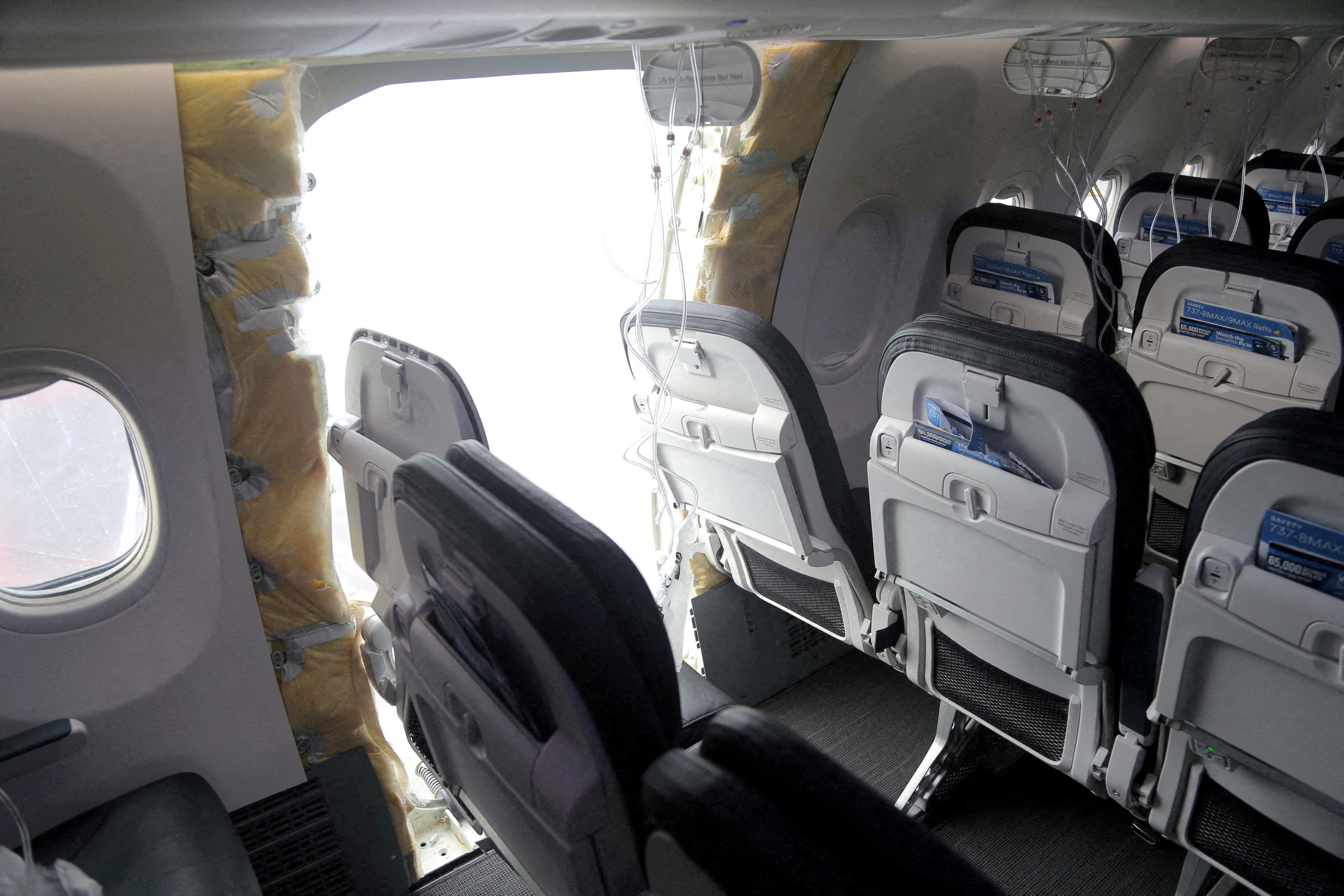
China scrutinises PwC role in $78 bln Evergrande fraud case, Bloomberg News reports
Chinese authorities are examining the role of PricewaterhouseCoopers(PwC) in China Evergrande Group's accounting practices after the developer was accused of a $78 billion fraud, Bloomberg News reported on Friday.


IMAGES
VIDEO
COMMENTS
Water flowing by the boat puts a great deal of pressure on a full keel rudder and makes the rudder hard to move. It takes a lot of force to push the rudder against the water moving past the boat. Spade rudders. Spade rudders are for fin keel boats rather than full keel boats. A spade rudder sticks straight down into the water.
A sailboat rudder comprises several components, each with a unique function that contributes to the rudder's overall effectiveness. The stock is the main vertical shaft that connects the rudder blade to the boat's helm. It is usually made of stainless steel or aluminum alloy and is designed to withstand the forces exerted on the rudder ...
Obviously, the rudder is a pretty important part of a sailboat. Without it, the boat cannot counter the forces put into the sails and cannot steer in a straight line. It also cannot control its direction, even under power. A rudder failure of any kind is a serious emergency at sea.
A sailboat rudder steers the boat. A rudder is a hinged fin or blade mounted on the stern of the vessel that turns side to side, and it's controlled by a tiller or a helm. A rudder is one of the primary controls of a sailboat. When the boat moves forward through the water, the rudder causes friction on one side and changes the direction of the ...
Know Your Rudder. After hull integrity, rudder integrity is the most vital component of a seaworthy vessel, yet most sailors pay more attention to LED lighting or smartphone apps than they do to their boat's rudder. Before you shrug off rudder failure as a remote concern, consider that the incidence of mid-ocean rudder failures is close to 1 ...
Sailboats steer by means of the rudder, a vertical, blade-like appendage mounted either on the transom (the flat surface of the stern) or under the boat.In both cases the rudder works by deflecting water flow: when the helmsman—the person steering, as likely female as male—turns the rudder, the water strikes it with increased force on one side, decreased force on the other.
The role of boat rudders in steering. Boat rudders play a vital role in steering a ship. When the helmsman turns the wheel or tiller, the rudder changes its angle, redirecting the water flow on one side of the boat, creating more resistance on that side, and causing the boat to turn in the opposite direction. Types of boat rudders
Some fin keel sailboats have a skeg-mounted rudder like the one shown. The skeg offers the same advantages as a keel mounted rudder: the rudder is protected from objects in the water and has more structural strength than a rudder mounted only on the rudder post. It also has the same disadvantage: because it is not "balanced" as a spade ...
The boat will rest safely on its side until the tide returns and lifts the boat off the shoal. Spade Rudder. The spade rudder rests below the transom separate from the keel. A spade rudder turns easily because the water rushes both against its fore and aft edges - good when using a tiller. There's less wet area so the spade rudder is fast.
Thus, rudders on high-performance sailing vessels are said to have a high-aspect ratio. Walking around a boatyard one day and measuring a few cruising sailboat rudders, I came up with aspect ratios of between 1.7 and 2.1, while one high-performance sailing vessel's rudder came in at 3.5.
A rudder steers a ship by generating areas of high and low pressure.There are numerous types of rudder available, with some offering advantages over others. ...
This design of sailboat rudder is something of a compromise between the spade rudder and the full skeg rudder. Supported at its mid-point by a half-depth skeg, it benefits by the area forward of the stock, below the skeg. This applies a balancing force as the rudder is turned making the steering lighter than it would otherwise be.
There are five main ways that a rudder can break and cause a boat to lose steerage. 1. Rudder stock failure: The rudder stock sometimes fails when bending stress in the stock exceeds the strength of the material. With a spade rudder, this usually occurs just below the lower rudder bearing, at the point of maximum bending load.
In other words, the 36-inch tiller should not be more than about 2 inches off the center line. If the boat is wheel steered, next time the boat is out of the water, measure the rudder angle with the wheel hard over. Count the number of turns of the wheel it takes to move the rudder from centered to rudder hard over, and measure the wheel diameter.
Sep 24, 2020. Maneuvering a twin-rudder boat like this Beneteau Oceanise 30.1 requires a slightly different mindset. Photo courtesy of courtesy of Beneteau. Twin-rudder raceboats have been with us since the mid-1980s. In the last 10 years or so, they've also become increasingly popular aboard cruising boats, including those available for charter.
Rudder on a Full-keel sailboat. Full-keel boats or modified full keel boats usually have this type of Rudder. These rudders are typically hinged to the aft edge of the keel to make a continuous surface, not to create any drag after the main keel. Engine propeller is usually positioned between the keel and the Rudder. Pros
Sailboats steer by means of the rudder, a vertical, blade-like projection mounted either on the transom (the flat surface of the stern) or under the sailboat. In both cases the rudder works by deflecting water flow: when the helmsman—the person steering,—pivots the rudder, the water hits it with increased force on one side, decreased force ...
A thorough inspection of the sailboat rudder while it's in place can often yield clues to whether removal is the right approach. In many cases, the only portion of the rudder that can't be easily inspected is the stock, where it passes through the trunk or log. Depending upon the design, removing the stuffing box from the trunk may enable ...
A rudder is a one-of-a-kind technological achievement for sailboats. There are a handful of rudder types for sailboats to allow sailors to steer. Today's sailboats use various rudders that serve unique purposes in steering or performance. You are probably wondering which rudder type you have on your boat and which one is best.
Glass one side of the rudder, let cure. Cut off excess edge stuff and rough sand/grind. Glass other side of rudder, let cure. Cut off excess, sand until flush. Glass edges based upon which were generally 'up' when clamped in a mostly horizontal way (images 4 and 5). Glass the remaining edges.
Skeg rudders are the most common type of rudder used on sailboats. They are simple in design and easy to operate. Skeg rudders are attached to the back of the boat with a metal or wooden skeg. This skeg provides support and helps to prevent the rudder from damage. Skeg rudders are typically used on smaller sailboats.
Sailboats do have rudders. The use of wind power to sail is the main feature of a sailboat. And the steering equipment that helps in making turns is the rudder. It is an underwater blade that works using a lever. This blade functions by creating unequal pressure of water.
The rudder is what steers the boat; thus, if it is excessively large, it could be challenging to manage the boat's direction. A boat might become slower if its rudder is excessively large and causes drag. How Much Is a New Rudder? The kind, size, and material all affect the price of a new rudder. A sailboat's rudder can usually range ...
The rudder pedals began working again as the pilots taxied to the gate with 155 passengers and six crew members on the flight from Nassau, Bahamas, according to a preliminary report by the National Transportation Safety Board. Boeing said this is the only rudder-response issue reported on a Max, although two similar incidents happened in 2019 ...
The National Transportation Safety Board (NTSB) is investigating a United Airlines Boeing 737 MAX 8 flight last month that experienced "stuck" rudder pedals after it touched down on the runway for ...